#fire force rpg
Explore tagged Tumblr posts
Text

olá galera que curte um rpg! venho propagar uma ideia que já tive em outra plataforma e que decidi trazer para o tumblr! o rpg seria com a temática do anime fire force, que tem o foco em bombeiros! seria uma temática bem diferente e dinâmica, com bastante interações e diversão. se é o que você procura irá encontrar aqui. clica no CONTINUE LENDO que tem a HISTÓRIA, caso se interessem me mandem ask perguntando sobre ou dm se quiserem que eu dê origem ao rpg aqui na plataforma tumblr.
[ HISTÓRIA ]
•
⠀⠀⠀⠀⠀Ano 198 da Era Solar. O mundo é totalmente dominado por chamas. Ou quase. As causas de mortes são muitas e variadas. Velhice, suicídio, doenças... Mas a causa da morte que mais assusta as pessoas nos dias de hoje é a combustão humana espontânea. Há exatamente trinta anos atrás foi que se deu o primeiro evento que aterrorizou a todos. Os humanos que entram em combustão se tornam incontroláveis demônios que incendeiam tudo que se vê pela frente, nomeados de Infernais. O caos se instalou. O mundo ficou em pedaços. Em alguns lugares o espaço se distorceu de tal maneira a esculpir continentes, e muitos dos países que outrora existiram, sucumbiram. Neste momento, há poucos locais aptos para se viver decentemente, sendo eles o Império Russo. As pessoas se reuniram na Rússia que estava relativamente ilesa e se organizaram em oito distritos, onde o Templo Sagrado do Sol e a Indústria E - LUMINATE desenvolveram o Amaterasu, uma usina de energia térmica perpétua. Dessa forma, o Império Russo fez-se beneficiário de sua vasta energia e também realizou outros avanços.
⠀⠀⠀⠀⠀Para enfrentar o problema em relação aos Infernais foi-se criado a partir da união entre três forças: O Templo Sagrado do Sol, as Forças Armadas da Rússia e a Agência de Defesa de Incêndios os Bombeiros Especiais. A influência dessas forças é diferente em cada distrito. Por exemplo, no 1° é o Templo Sagrado do Sol. O 2° responde diretamente às Forças Armadas. No 5° o verdadeiro poder é das Indústrias E-LUMINATE que inclusive são responsáveis pela confecção do equipamento dos Bombeiros Especiais. Eles tem monopólio dos pedidos de produtos e controlam muito do capital e de interesses. Em suma, o dever de cada companhia é colocar os Infernais para descansar, procurar a causa da combustão humana espontânea e lutar no lugar das pessoas. Mas, com a supremacia dos poderes individuais, cada companhia mantém as informações que obtém para si mesmo e nada é dividido. O 8° distrito é um corpo que alguns da Agência de Defesa de Incêndio forçaram a criação, montada com aqueles em que podiam confiar para investigar as Companhias e os membros suspeitos do 1° distrito ao 7°, para descobrir a verdade.
[ NAVEGAÇÃO ]
•
GERAÇÕES — 1G • 2G • 3G
#rp#rpg#fantasy rp#skeleton rp#original rpg#rpg br#rpg brasil#open rp#rp br#original rp#divulgações#rpg maker#fire force#fire force rpg#ff rp#rp brasil
1 note
·
View note
Text
Oh man, I've been hit with the tactical RPG itch. It started with Final Fantasy Tactics, and when I finished that I went onto Tactics Advance. And now I've gotten to things like Shining Force, Arc the Lad, Disgaea, and Tactics Ogre... Maybe now I'll actually be able to finish a Fire Emblem game
#video games#jrpg#tactical rpg#strategy rpg#trpg#srpg#final fantasy tactics#shining force#arc the lad#disgaea#tactics ogre#fire emblem#fell seal#triangle strategy#langrisser
13 notes
·
View notes
Text

UK 1987
#UK1987#SSI#STRATEGY#WARGAME#RPG#CREATIVE#SIMULATION#APPLE#ATARI400/800#IBM#C64#AMIGA#ATARIst#SHARP X1#PC 98#MSX#PC 88#RAODWAR 2000#KNIGHTS OF THE DESERT#WARGAME CONSTRUCTION KIT#TIGERS IN THE SNOW#FIGHTER COMMAND#CARRIER FORCE#FIELD OF FIRE#MECH BRIGADE#PHANTASIE II#VIETNAM#GERMANY 1985MBATTALION COMMANDER#PHANTASIE#RDF 1985
10 notes
·
View notes
Text
DEJA VU DISCORD RPG.
✿𝑫𝑬𝑱𝑨 𝑽𝑼: 𝑹𝑬𝑫𝑬𝑴𝑷𝑻𝑰𝑶𝑵. Demons linger in the dark — awaiting their chance to devour the very souls that they harbor. After so much heartache and turmoil that has befallen the people of Belfiore, redemption is within it's horizon; answers from corrupted memories begin to reveal themselves to a select few. From the horror they faced with corrupted Knights to the deaths and imprisonment of their loved ones, there is finally a chance for a 𝒃𝒆𝒕𝒕𝒆𝒓 tomorrow; however, no moment of peace is set in stone. The chance for happiness is within reach, but at what cost?
✷18+ ONLY. ✷〔We are a MULTI-FANDOM anime roleplay server that welcomes 50+ verses ranging from isekai, shounen, fantasy, romance, vampires, selective video games and more! We also allow the ability to request series we may not have listed if it fits in this world!〕 ✷〔We require one application to join the server — after that, the request for multiple characters is much easier if you're active! You can even start with up to three characters once your application is approved〕
⋆ ・ ⠄⠂⋆ ・ ⠄⠂⋆ ・ ⠄⠂⋆ ・ ⠄⠂⋆ ・ ⠄⠂⋆ ⋆ ・ ⠄⠂⋆ ・ ⠄⠂⋆ ・ ⠄⠂⋆ ・
𝑺𝒀𝑵𝑶𝑷𝑺𝑰𝑺 Unbeknownst to you, you’ve been 𝑷𝑳𝑼𝑪𝑲𝑬𝑫 from your world and thrown into a new one; however, the life before is lost within time. You don’t remember your previous life; however, there are familiar faces and places you feel that you know— It’s like you’re having 𝑬𝑵𝑫𝑳𝑬𝑺𝑺 Deja Vu, but can't seem to understand why and have no way to leave. 𝑾𝑬𝑳𝑪𝑶𝑴𝑬 𝑻𝑶 𝑩𝑬𝑳𝑭𝑰𝑶𝑹𝑬 — a medieval world hidden behind walls with modernized technology and a place, though it seems quaint, may not be all that it appears to be.
「Could there be a chance you can regain the life you’ve once known?」 「Is there a 𝑻𝑹𝑼𝑻𝑯 behind the layers of deceit that are worth unveiling?」
⋆ ・ ⠄⠂⋆ ・ ⠄⠂⋆ ・ ⠄⠂⋆ ・ ⠄⠂⋆ ・ ⠄⠂⋆ ⋆ ・ ⠄⠂⋆ ・ ⠄⠂⋆ ・ ⠄⠂⋆ ・
★ LGBTQ+ accepting community! 🏳️🌈 ★ Friendly & punctual staff, attentively active admins. NO TOLERANCE for OOC drama/toxicity. ★ A level system to help gauge tolerance and assist in avoiding possible triggers. ★ No character limit! ★ Original Characters are welcomed here ! ★ Tupperbox bot as a proxy for multi-muses. ★ OOC & IC chats/channels. ★ Self roles for convenience of personalization. ★ Literate and Semi-Literate Roleplay. ★ A unique system to implement literate role-play and crack role-play to keep members engaged with various platforms. ★ Various Guilds to choose from that can unique fit the niche of your character! ★ Pleasing server aesthetic & cute anime emotes ~! If you wish to join, you can find more information here along with our discord link: https://dejavu-rp.carrd.co/
#fandom rp#multifandom rp#animerp#discord group rp#discord rp#discord rpg#anime rp#trigun rp#video game rp#re:zero rp#black clove rp#fire force rp#death mount play rp#isekai rp#isekairp#naruto rp#one piece rp#crossover rp#manga rp#manwha rp#jjkrp#jjk rp#jujutsu kaisen rp#demon slayer rp#rwby rp#fire emblem rp#princess tutu rp#persona rp#persona series
9 notes
·
View notes
Text
Bioware: So Dragon Age: Inquisition was a hit and we need to get working on a sequel ASAP so the hype stays fresh.
EA: We want you to work on Anthem.
BW: Nobody likes Anthem.
EA: So work on it and make people like it. Work on this other thing on the side.
BW: [Years later, ready to gear up] We have all these great ideas, look at these concepts, the fans will love it!
EA: ...But what if you made it an MMO instead?
BW: Fans don't want an MMO.
EA: But we can make extra money off microtransactions
BW: The fans don't want an MMO.
EA: You're making an MMO or this studio is being closed.
BW: [has to scrap half of what they are doing to make an MMO]
Testers: Where is our fucking single player RPG?
EA: Wouldn't you rather have an MMO?
BW/Testers: NO
EA: Bioware, make it a single player rpg. You whiners. But you have a deadline and we're not giving you anymore money so you have to make it out of this 80% finished Dragon Age MMO we definitely weren't forcing you to make.
BW: [Have no choice but to make lemonade] Wow, that's 1.5 million active players in the first two months! That's great, especially since it's so long after the last game!
EA: Yeah...but we wanted THREE MILLION.
BW: None of your games in the last ten years have had that many.
EA: AND you didn't win GOTY. We're firing the rest of your staff.
BW: Are you fucking kidding
EA: Dragon Age: The Veilguard was a total failure because it wasn't an MMO.
1K notes
·
View notes
Text
1K notes
·
View notes
Text
Edge – The Future of Interactive Entertainment magazine, issue #401 (October 2024 issue) – Dragon Age: The Veilguard story
The rest of this post is under a cut for length.
Update: this issue of this magazine is now available to buy from UK retailers today. it can be purchased online at [this link]. [Tweet from Edge Online] also, Kala found that a digital version of the magazine can be read at [this link].
This post is a word-for-word transcription of the full article on DA:TV in this issue of this magazine. DA:TV is the cover story of this issue. When transcribing, I tried to preserve as much of the formatting from the magazine as possible. Edge talked to BioWare devs for the creation of this article, so the article contains new quotes from the devs. the article is written by Jeremy Peel. There were no new screenshots or images from the game in the article. I also think that it contains a few lil bits of information that are new, like the bits on companions' availability and stumbling across the companions out and about on their own in the world e.g. finding Neve investigating an abduction case in Docktown.
tysm to @simpforsolas and their friend for kindly telling me about the article!!
-----

[image source]
Article introduction segment:
"[anecdote about Edge] We were reminded of this minuscule episode in Edge's history during the creation of this issue's cover story, in which we discuss the inspiration behind Dragon Age: The Veilguard with its creators at BioWare. Notably, director John Epler remembers the studio experimenting with a number of approaches during the early phase of development before eventually locking in to what the game was supposed to be all along, above all else: 'a single-player, story-focused RPG'. As you'd expect from BioWare, though, that was really just a starting point, as we discovered on p54." BioWare draws back the Veil and ushers us into a new Dragon Age
"BEHIND THE CURTAIN BioWare's first true RPG in age age is as streamlined and pacey as a dragon in flight. By Jeremy Peel Game Dragon Age: The Veilguard Developer BioWare Publisher EA Format PC, PS5, Xbox Series Origin Canada Release Autumn
The Dragon Age universe wasn't born from a big bang or the palm of an ancient god. Instead, it was created to solve a problem. BioWare was tired of battling Hasbro during the making of Baldur's Gate and Neverwinter Nights, and wanted a Dungeons & Dragons-like setting of its own. A small team was instructed to invent a new fantasy world in which the studio could continue its groundbreaking work in the field of western RPGs, free of constraints.
Well, almost free. BioWare's leaders mandated that the makers of this new world stick to Eurocentric fantasy, and include a fireball spell - since studio co-founder Ray Muzyka had a weakness for offensive magic.
Beyond that, BioWare’s storytellers were empowered to infuse Dragon Age with their own voices and influences, leaning away from D&D’s alignment chart and towards a moral grayness that left fans of A Song Of Ice And Fire feeling warm and cozy.
In the two decades since, the world of Thedas – rather infamously and amusingly, a shortening of ‘the Dragon Age setting’ that stuck – has taken on a distinct flavor. It’s something director John Epler believes is rooted in characters.
“There’s definitely some standard fantasy stuff in Dragon Age, but everything in the world, every force, is because of someone,” he says. “The idea is that every group and faction needs to be represented by a person – someone you can relate to. Big political forces are fine as background, but they don’t provide you with those interesting story moments.”
Dragon Age: The Veilguard bears out that philosophy. The long-awaited sequel was first announced with the subtitle Dreadwolf, in reference to its antagonist, Solas – an ancient elf who once stripped his people of immortality as punishment for betraying one of their own. In doing so, Solas created the Veil, the thin barrier through which wizards pull spirits and demons invade the waking world. In other words, many of Dragon Age’s defining features, from its downtrodden elves to the uneasy relationship between mages and a fearful church, can be traced right back to one character’s decision.
“The world exists as it does because of Solas,” Epler says. “He shaped the world because of the kind of character he was. That’s, to me, what makes Dragon Age so interesting. Everything can tie back to a person who to some degree thought they were doing the right thing.”
Perhaps BioWare’s greatest achievement in slowburn character development, Solas is a former companion, an unexploded bomb who sat in the starting party of Dragon Age: Inquisition, introverted and useful enough to get by without suspicion. Yet by the time credits rolled around on the Trespasser DLC, players were left in no doubt as to the threat he presented.
Determined to reverse the damage he once caused, the Dreadwolf intends to pull down the Veil, destroying Thedas as we know it in the process. The next Dragon Age game was always intended to be his story.
“We set that up at the end of Trespasser,” Epler says. “There was no world where we were ever going to say, ‘And now let’s go to something completely different.’ We wanted to pay off that promise.”
Yet almost everything else about the fourth Dragon Age appears to have been in flux at one time. In 2019, reporter Jason Schreier revealed that an early version, starring a group of spies pulling off heists in the Tevinter Imperium, had been cancelled two years prior. Most of its staff were apparently moved onto BioWare’s struggling Anthem, while a tiny team rebooted Dragon Age from scratch. That new game was said to experiment with live-service components.
“We tried a bunch of different ideas early on,” Epler says. “But the form The Veilguard has taken is, in a lot of ways, the form that we were always pushing towards. We were just trying different ways to get there. There was that moment where we really settled on, ‘This is a singleplayer, story-focused RPG – and that’s all it needs to be’”.
Epler imagines a block of marble, from which BioWare was attempting to carve an elephant – a character- and story-driven game. “We were chipping away, and sometimes it looked more like an elephant and sometimes it didn’t”, he says. “And then we eventually realized: ‘Just make an elephant’. When we got to that, it almost just took shape by itself.”
2014’s Dragon Age: Inquisition was an open-world game commonly criticized for a slow-paced starting area which distracted players from the thrust of the plot. The Veilguard, in contrast, is mission-based, constructed with tighter, bespoke environments designed around its main story and cast. “We wanted to build a crafted, curated experience for the player,” Epler says. “Pacing is important to us, and making sure that the story stays front and center.”
Epler is very proud of Inquisition, the game on which he graduated from cinematic designer to a lead role (for its DLC). “But one of the things that we ran into on that project was an absentee antagonist,” he says. “Corypheus showed up and then disappeared. You spent ten hours in the Hinterland doing sidequests, and there wasn’t that sense of urgency.”
This time, The Veilguard team wants you to constantly feel the sword of Damocles dangling above your head as you play – a sense that the end of the world is coming if you don’t act. “There’s still exploration – there’s still the ability to go into some of these larger spaces and go off the beaten path to do sidequests,” Epler says. “But there’s always something in the story propelling you and the action forward, and allowing you to make decisions with these characters where the stakes feel a lot more immediate and present. And also, honestly, more real.”
No sooner have you finished character creation than Dragon Age: The Veilguard thrusts you into a choice. As your protagonist, Rook, steps into focus on the doorstep of the seediest bar in town, you decide whether to threaten the owner for information or make a deal. Brawl or no, you’ll walk out minutes later with a lead: the location of a private investigator named Neve Gallus, who can help you track down Solas.
You proceed into Minrathous, the largest city in Thedas and capital of the Tevinter Imperium – a region only alluded to in other Dragon Age games. It’s a place built on the backs of slaves and great mages, resulting in tiered palaces and floating spires – a kind of architecture unimaginable to those in the southern nations.
“When your Dragon Age: Inquisition companion Dorian joins you in Orlais, in one of the biggest cities in Thedas, he mentions that it’s quaint and cute compared to Minrathous,” Corinne Busche, game director on The Veilguard, says. “That one bit of dialogue was our guiding principle on how to realize this city. It is sprawling. It is lived-in. Sometimes it’s grimy, sometimes it’s bougie. But it is expansive.”
Immediately, you can see the impact of BioWare’s decision to tighten its focus. Around every other corner in Minrathous is an exquisitely framed view, a level of spectacle you would never see in Inquisition, where resources were spread much more thinly. “When you know that you’re gonna be heading down a canyon or into this plaza where the buildings open up, you have those perfect spots to put a nice big temple of Andraste or a mage tower,” art director Matthew Rhodes says. “You get those opportunities to really hit that hard.”
BioWare’s intention is to make strong visual statements that deliver on decades of worldbuilding. “People who have a history with Dragon Age have thought about what Minrathous might be like,” Rhodes says. “We can never compete with their imagination, but we can aim for it like we’re shooting for the Moon.”
The people of Tevinter use magic as it if were electricity, as evidenced by the glowing sigils that adorn the dark buildings – street signs evoking Osaka’s riverfront or the LA of Blade Runner. They’re just one of the tricks BioWare’s art team uses to invite you to stop and take in the scene. “A lot of what you start to notice when you’re the artist who’s been working on these big, beautiful vistas and neat murals on the walls is how few players look up,” Rhodes says. “We design props and architecture that help lead the eyes.”
For the really dedicated shoegazers, BioWare has invested in ray-traced reflections, so that the neon signage can be appreciated in the puddles. There are also metal grates through which you can see the storm drains below. “The idea behind that is purely just to remind the player often of how stacked the city is,” Rhodes says. “Wherever you’re standing, there’s guaranteed to be more below you and above you.”
One of BioWare’s core creative principles for The Veilguard is to create a world that’s actually worth saving – somewhere you can imagine wanting to stick around in, once the crises of the main quest are over. To that end, the team has looked to ground its outlandish environments with elements of mundanity.
“A guy’s normal everyday life walking down the streets of this city is more spectacular than what the queen of Orlais is seeing, at least in terms of sheer scale," Rhodes says. “One of the things we’ve tried to strike a balance with is that this is actually still a place where people have to go to the market and buy bread, raise their kids, and try to make it. It’s a grand and magical city, but how do you get your horses from one place to the next? Where do you load the barrels for the tavern? It’s really fun to think of those things simultaneously.”
Normal life in Minrathous is not yours to behold for long, however. Within a couple of minutes of your arrival, the very air is ripped open like cheap drapes, and flaming demons clatter through the merchant carts that line the city streets. A terrible magical ritual, through which Solas intends to stitch together a new reality, has begun.
“We wanted the prologue to feel like the finale of any other game we’ve done,” Busche explains. “Where it puts you right into this media-res attack on a city and gets you really invested in the action and the story right away. When I think back to Inquisition, how the sky was literally tearing open – the impact of this ritual really makes that look like a minor inconvenience.”
Our hero is confronted by a Pride demon, imposing and armored as in previous games, yet accented by exposed, bright lines that seem to burst from its ribcage. “They are a creature of raw negative emotion,” Busche says. “So we wanted to actually incorporate that into their visual design with this glowing nervous system.”
When a pack of smaller demons blocks Rook’s route to the plaza where Neve was last seen, battle breaks out, and The Veilguard’s greatest divergence from previous Dragon Age games becomes apparent. Our rogue protagonist flits between targets up close and evades individual sword swings with precision. In the chaos, he swaps back and forth between blades and a bow. He blends light and heavy attacks, and takes advantage of any gap in the melee to charge up even bigger blows.
“Responsiveness was our first-and-foremost goal with this baseline layer of the combat system,” Busche says. Unless you’re activating a high-risk, high-reward ability such as a charged attack, any action can be animation-cancelled, allowing you to abort a sword swing and dive away if an enemy lunges too close. “We very much wanted you to feel like you exist in this space, as you’re going through these really crafted, hand-touched worlds,” Busche says. “That you’re on the ground in control of every action, every block, every dodge.” Anyone who’s ever bounced off a Soulslike needn’t worry: The Veilguard’s highly customizable difficulty settings enable you to loosen up parry windows if they prove too demanding.
Gone is the overhead tactical camera which, for some players, was a crucial point of connection between Dragon Age and the Baldur’s Gate games that came before, tapping into a lineage of thoughtful, tabletop-inspired combat. Epler points out that the camera’s prior inclusion had an enormous impact on where the game’s battles took place. “We actually had a mandate on Inquisition, which was, ‘Don’t fight inside,’” he says. “The amount of extra work on getting that tactical camera to work in a lot of those internal environments, it was very challenging.”
Gone, too, is the ability to steer your comrades directly. “On the experiential side, we wanted you to feel like you are Rook – you’re in this world, you’re really focused on your actions,” Busche says. “We very much wanted the companions to feel like they, as fully realized characters, are in control of their own actions. They make their own decisions. You, as the leader of this crew, can influence and direct and command them, but they are their own people.”
It's an idea with merit, albeit one that could be read as spin. “It’s not lost on me,” Busche says. “I will admit that, on paper, if you just read that you have no ability to control your companions, it might feel like something was taken away. But in our testing and validating with players, what we find is they’re more engaged than ever.”
There may be a couple of reasons for that. One is that Dragon Age’s newly dynamic action leaves little room for seconds spent swapping between perspectives. “This is a much higher actions-per-minute game,” Busche says. “It is more technically demanding on the player. So when we tried allowing you full control of your companions as well, what we’ve found is it wasn’t actually adding to the experience. In fact, in some ways it was detrimental, given the demanding nature of just controlling your own character.”
Then there’s The Veilguard’s own tactical layer, as described by BioWare. Though the fighting might be faster and lower, like a mana-fuelled sports scar, the studio is keen to stress that the pause button remains as important to the action as ever. This is, according to Busche, where the RPG depth shines through, as you evaluate the targets you’re facing and take their buffs into account: “Matching elemental types against weaknesses and resistances is a big key to success in this game.”
You pick between rogue, warrior and mage – each role later splitting again into deeper specialisms – and draw from a class-specific resource during fights. A rogue relies on Momentum, which is built up by avoiding damage and being highly aggressive, whereas a warrior is rewarded for blocking, parrying, and mitigating damage.
Those resources are then used on the ability wheel, which pauses the game and allows you to consider your options. The bottom quadrant of the wheel belongs to your character, and is where three primary abilities will be housed. “Rook will also have access to runes, which function as an ability, and a special ultimate ability,” Busche says. “So you’re bringing five distinct abilities with you into combat.”
The sections to the left and right of the wheel, meanwhile, are dedicated to your companions. Busche points to Lace Harding, the returning rogue from Inquisition, who is currently frozen mid-jump. “She is her own realized individual in this game. She’s got her own behaviors: how she prioritizes targets, whether she gets up close and draws aggro or stays farther back at range. But you’ll be able to direct her in combat by activating her abilities from the wheel.”
These abilities are complemented by positional options at the top of the wheel, where you can instruct your companions to focus their efforts on specific targets, either together or individually. Doing so will activate the various buffs, debuffs and damage enhancements inherent in their weapons and gear. “So,” Busche explains, “as you progress through the first two hours of the game, this full ability wheel is completely populated with a variety of options and different tactics that you can then string together.”
BioWare has leaned into combos. You might tell one companion to unleash a gravity-well effect that gathers enemies together, then have another slow time. Finally, you could drop an AOE attack on your clustered and slowed opponents, dealing maximum damage. The interface will let you know when an opportunity to blend two companion abilities emerges – moments BioWare has dubbed ‘combo detonations’.
“I like to think about this strategic layer to combat as a huddle,” Busche says, “where you’re figuring out how you want to handle the situation, based on the information you have on the encounter, and how you and your companions synergize together.”
Deeper into the game, as encounters get more challenging, Epler says we’ll be spending a lot of time making “very specific and very focused tactical decisions”. The proof will be in eating the Fereldan fluffy mackerel pudding, of course, but Busche insists this shift to fast action isn’t a simplification. “What really makes the combat system and indeed the extension into the progression system work is that pause-and-play tactical element that we know our players expect.”
The autonomy of The Veilguard’s companions doesn’t end with combat. BioWare’s data shows that in previous games players tended to stick with the same two or three beloved comrades during a playthrough. This time, however, you’ll be forced to mix your squad up at regular intervals.
“We do expect that players will have favorites they typically want to adventure with,” Busche says, “but sometimes certain companions will be mandatory.” Others may not always be available – part of the studio’s effort to convince with three-dimensional characters. “They do have a life outside of Rook, the main character,” Busche says.
"They'll fall in love with people in this world. They’ve had past experiences they’ll share with you if you allow them in and get close to them.”
Being separated from your companions, rather than collecting them all in a kind of stasis at camp, allows you to stumble across them unexpectedly. Busche describes an instance in which, while exploring the Docktown section of Minrathous, you might bump into Neve as she investigates an abduction case. “If I go and interact with her, I can actually stop what I’m doing, pick up her arc and adventure with her throughout her part of the story,” Busche says. “What’s interesting is that all of the companion arcs do ultimately tie back to the themes of the main critical path, but they also have their own unique challenges and villains, and take place over the course of many different intimate moments.”
Some parts of a companion’s quest arc involve combat, while others don’t. Some are made up of large and meaningful missions – as lavish and involved as those along the critical path. “While they are optional, I would be hesitant to call them side content in this game,” Busche says. If you choose not to engage with some of these companion-centered events, they’ll resolve on their own. “And it might have interesting implications.”
The Veilguard promises plenty of change, then, even as it picks up the threads of fan-favorite characters and deepens them, honoring the decades of worldbuilding that came before it. This is perhaps the enduring and alluring paradox of Dragon Age: a beloved series which has never had a direct and immediate sequel, nor a recurring protagonist. Instead, it’s been reinvented with each new entry.
“It’s a mixed blessing to some degree,” Epler says. “The upside is always that it gives us more room to experiment and to try new things. There are parts of the series that are common to every game: it’s always an RPG, it’s always about characters, and we always want to have that strategic tactical combat where you’re forced to make challenging decisions. But at the end of the day, I think what makes Dragon Age Dragon Age is that each one feels a little bit different.”"
Q&A Matthew Rhodes Art director
Q. Early BioWare RPGs were literary, with the emotions and detail mostly happening in dialogue boxes. How have you seen the studio's approach to visual storytelling evolve? A. This has been my entire career. When I first showed up at BioWare, it was at the tail end of Jade Empire, and then I was working on Dragon Age: Origins and early Mass Effect. The games had taken that next step out of sprites and 2D models, and it was like: 'How do we say more? How do we communicate more clearly?' During those early days, a lot of games depended on words to fix everything for you. As long as your character was talking bombastically, you could lend them everything that they needed. But as time went on it also became a visual medium, and it's been this long journey of trying to establish art's seat at the table. I've worked with some great writers over the years, and art is also an essential part of the storytelling. From Dragon Age: Inquisition on, I've been trying to stress with my teams that we are a story department.
Q. Is part of that also letting writers know that your storytelling assistance is available, to help them show rather than tell? A. On The Veilguard, that principle has been operating the best I've seen it. Where you would need a paragraph of dialogue in one of those exposition moments where a character just talks to you, we could sell that with a broken statue or a skeleton overgrown with vines. We've had more opportunities to do that on The Veilguard than most of the projects I've ever worked on combined.
To a hammer, every problem looks like a nail, and so in every department, writing will try to solve it with more words, and art will try to solve it with more art. I've bumped up against moments where it's like, 'As much as we could keep hammering on this design, I think this is actually an audio solution.' And then you take it to audio, and you don't get that overcooked feeling where each team is just trying to solve it in their silo. It's a really creatively charged kind of environment.
[main body of article ends here]
Additional from throughout the article --
Image caption: “Spotlights shine down from the city guards’ base as they pursue you through the streets of Minrathous.”
Image caption: “While most of your companions can be sorted into comfortingly familiar RPG classes, The Veilguard introduces two new varieties: a Veil Jumper and a private investigator.”"
Image caption [on this Solas ritual concept art specifically]: “The name previously given to the game – Dreadwolf – was a direct reference to Solas. Your former companion, now on his own destructive mission, still features, despite the name change.”
Text in a side box:
"RATIONAL ANTHEM The hard lesson BioWare drew from Anthem was to play to its strengths. “We’re a studio that has always been built around digging deep on storytelling and roleplaying,” Epler says. “I’m proud of a lot of things on Anthem – I was on that project for a year and a half. But at the end of the day we were building a game focused on something we were not necessarily as proficient at. For me and for the team, the biggest lesson was to know what you’re good at and then double down on it. Don’t spread yourselves too thin. Don’t try to do a bunch of different things you don’t have the expertise to do. A lot of the people on this team came here to build a story-focused, singleplayer RPG."
Image caption: “In combat you no longer control your companions directly – this is a faster-paced form of fighting – but you are able to direct them in combat, and can even blend their abilities in ‘combo detonations’.”
Image caption: “You’ll be exploring new regions across Tevinter and beyond – Rivain is a certainty, and that’s only accessible via Antiva travelling overland.”
Image caption: “There are three specializations per character class; on the way to unlocking them you’ll acquire a range of abilities.”
Text in a side box:
"MEET YOUR MAKER “Full disclosure: Dragon Age has traditionally not done skin tones well, especially for people of color,” Busche says. “We wanted to do a make-good here.” In The Veilguard’s character creator, you can adjust the amount of melanin that comes through in the skin, as well as test various lighting scenarios to ensure your protagonist looks exactly as you intend in cutscenes. “Speaking of our first creative principle – be who you want to be – we really feel these are the kinds of features that unlock that for our players,” Busche says. “We want everyone to be able to see themselves in this game.” For the first time in the series, your body type is fully customizable too, with animations, armor and even romantic scenes reflecting your choices."
Image caption: “Your companions are a mix of old and new – Lace Harding is a familiar face. Veil Jumper Bellara is new, with a new occupation, while Davrin is a new face with a familiar profession – he’s a Warden.”
Image caption: "Arlathan Forest is home to the ruined city of the elves, now a place of wild magic, Veil Jumpers and (allegedly) spirits".
Image caption: "Bellara is driven by a desire to learn more about the elves, rediscovering the shattered history and magic of her people."
[source: Edge – The Future of Interactive Entertainment magazine, issue #401 (October 2024 issue) - it can be purchased online at [this link].]
#dragon age: the veilguard#dragon age the veilguard spoilers#dragon age: dreadwolf#dragon age 4#the dread wolf rises#da4#dragon age#bioware#solas#video games#longpost#long post#simpforsolas#anthem#jade empire#mass effect#obsessed with the idea of helping neve solve cases...
416 notes
·
View notes
Note
Your fics are amazing! Would you ever write about König?
𝐂𝐑𝐘𝐏𝐓𝐈𝐃 — 𝐊𝐎𝐍𝐈𝐆
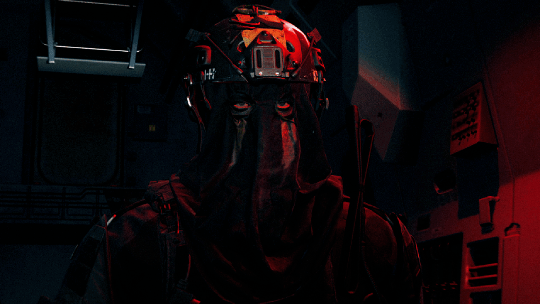


synopsis : rumours of an elite soldier have the base reeling. murmurings of 'monster' and 'freak'. what happens when you come face to face with the beast, only to find he's nothing like the whispers cautioned?
pairing : könig x f!reader
warnings : 18+ mdni. war, violence, graphic gory imagery, self-conscious könig baby, little bit of hand kink, basic bitch smut, p in v sex, unprotected sex, size kink, tight fit, sugar-sweet teeth rotting smut. this feels so basic… but I was struggling. please note, kilgore is a name previously linked to könig. I have used it as a codename 🙂
könig masterlist ୨୧ main masterlist ୨୧ join taglist ୨୧ ask


Warfare training preps for the inevitable—those moments you need to fire a weapon and how to camouflage and navigate enemy territory without detection. These inescapable horrors are 'another day in the office' by the time you enter the field, the prickling chill of fear driven out of your system. Whistling RPGs are not dissimilar to the scream of your Drill Sergeant's commands, the cold, hard ground of a dilapidated building no more uncomfortable than the standard-issue barracks mattress you would ease your wearing bones into after training.
Fear, beaten out of each man and woman that slipped on the uniform, held no commonplace in the military. Weapons, the call to war, brutality and sirens did little to raise the blood pressure.
Whispers held far more weight and struck unease into the hearts of even the most desensitised of fighters.

It was inarguable that each military in every country, at any time, had its own 'boogeyman'. Notorious fighters with absurdly large kill counts consisting of three digits that inevitably earned a bounty for their head, funded by the enemy—elite warriors who acquired a legendary reputation that ultimately became horror stories. The Ghost of Kyiv, The American Sniper Chris Kyle. These military cryptids kept their enemies awake at night, baying for blood and begging for the piles of bodies they left behind to stop growing.
After years in the SAS, you were beginning to think that there was no such thing. Each soldier was prolific, brutally efficient and inarguably the best of the elite forces. It was only upon entering Task Force 141, a genuinely mean feat, that you began to hear the unshunnable, hushed whispers of Kilgore.
“Did you hear about Berlin?”
“Kilgore? Yeah, heard he blew away a whole Al-Qatala cell.”
“Twelve of ‘em. The hostages were traumatised.”
These mumblings had persisted for months, consistently updated with crazy tales of whole garrisons blown to smitheries by this massacre-happy hulking mass of pure military precision. You, like the rest of 141, elected to ignore the gossip. This was a battlefield, filled with elite soldiers, not a school playground.
✰
Austrian mud splatters your camo-clad shins as you sprint through the forest terrain, your heart lurching in your chest as your rain-soaked fingers almost fumble your gun to the sodden ground. It’s freezing cold, the gush of rain edging on a flurry of sleet as lightning cracks above your head. Clothes soaked through, the moisture and icy wind form something of a ‘Pact of Steel’, working together to deep freeze the marrow of your bones.
As you slip in the mud again, heel skidding across the slick soil, you realise how dire the situation truly is. Separated from 141 during the firefight, you’d navigated north. You continued running for the safe house once discovering your coms had been dispatched by a stray bullet— that certainly would have ripped through your heart and dispatched you instantly if not for the layers of plastic settled over it.
Thunder rumbles in the clouds above, the boom reminiscent of a distant air strike. Slurried earth gives way beneath your feet as you push on. Exhaustion gnaws at your joints as you scramble for safety, bested only by the adrenaline that buzzed in your ear like a vicious drill sergeant. “Move it! Do you wanna die?! Well fucking move!”
You can hear their boots in the mud, the advancing Al-Qatala mercenaries chasing after you and shooting blindly at your heels, competing with the distance and dense foliage. You’re like an injured fox, feverish bloodhounds nipping at the end of your tail— what could they do with an SAS hostage? How much leverage would it buy?
Bullets whistle by your feet, the proximity of some enough to set your hair on end. They’re closing in, jowls dripping with slobber as they attempt to close their teeth around you. Just a little mor—
Crack.
Chaos erupts behind you, the thump of a body and a flurry of shouts. Panicked voices overlay each other in different languages, Urzik and Persian. You scramble for cover behind a treetrunk, the bark cutting at your palms as you brace for incoming fire.
"Kilgore!" Someone shouts, and your blood runs cold, eyes wide as they dart around the foliage for the legendary soldier. The whizzing of high-powered bullets persists, dropping Al-Qatala mercenaries into the mud beneath them. You hear the yelled orders, Urzik fighters urged to retreat.
You're unsure if one fails to hear the directive over the din of warfare, but you hear the advancing feet of the mercenary advancing on your position—the squelch of the mud beneath the rubber sole of his combat boots. You scramble with your weapon, checking the gun's safety and readying for a one-shot shoot-out.
When a bullet shreds through a victim's head, the sound is reminiscent of a watermelon being cracked open. It's a sickening crunch. A wet spray of warm blood cuts through the downpour of rain, splattering across your face. Some of it is solid, brain matter and shards of cranium.
It's not silent by any means. The rain continues to beat against the floor, pattering in the puddles that had formed in sole-shaped prints in the soaked earth. Cracks of thunder sound in the distance, and the droplets drum against the leaves in the forest's canopy. However, the sounds of the firefight cease.
"You can come out," a voice calls to you. Accented; Germanic. You hesitate for a moment, once again strengthening your grip on the gun you'd clung to. Your lungs strain with the sudden intake of breath, ribs crushed beneath your tac-vest. "Ghost sent me."
Easing your head out from behind the tree trunk, you marvel, somewhat horrified, at the gigantic, hulking build of the man who stood in the clearing. Fallen enemy combatants surround him, a blanket of corpses draped across the turbid forest floor. A black veil covers his face, and his equipment litters his tac-vest.
You'd be lying if you said you were unperturbed by the sight. Instead, fear lurches in the pit of your stomach, and you freeze in place. It's only when your eyes catch the crystal white slicing through crimson on the patch sewn into his shoulder that the airy voice, which certainly doesn't match his enormous frame, brings you a sense of safety.
"The safe house is ahead. We could get you warm–– clean you up?"
✰
Staring into the bubbling pan of water settled over the small fire, you relish in the warmth that creeps across your chilled body. Still, you're soaked, the damp clinging to the threads of your clothes. The scent of iron still assaults your nose, the water that you pick off the fire cautiously heated enough to scrub the blood from your face.
Kilgore, who informed you upon entering the safehouse preferred to be called by his name König, had seated himself in the corner of the large, relatively empty room. He looked ridiculous like this, attempting to compact his body into the crevice. You don't doubt it's an attempt to ease the nervous energy bleeding through your pores, your hands trembling as you attempt to dip the rag he had gifted you into the hot water.
"Did..." You swallow thickly, glancing up at the Austrian, "Did you tell the Lieutenant where we are?"
"Mhm-hm," he nods slowly, his jade eyes watching you from beneath the face veil. They're sharp and bright, contrasting so strongly against his uniform's muted and inky shades. "He's planning evac."
You scrub the gore from your face, wincing as you feel the shards of bone scrape across your face. König's eyes bore into you from the other side of the room, watching you struggle to remove what was left of the grime the rain had failed to wash away.
"I've-... Heard a lot about you," you speak to him, attempting to cross the vast space he had consciously put between you. His green eyes gaze at you, unblinking as he watches your expression. König is trying to read you, trying to comprehend how you feel. He's cautious, trying not to push you outside of your comfort zone.
"About Berlin?" He asks, and his voice is so soft that it reminds you of a child attempting to speak after being reprimanded by their parents–– wary of a second bout of raised voices.
"Yes," you mumble, dipping the crimson rag into the water before laying it across your skin again, "About Berlin."
König hums softly, casting his eyes to the aged, wooden floorboards. The woodlice have chewed through them, moss growing in some parts. You can see he appears uncomfortable, his knuckles white from the fists that form in his lap.
"I didn't mean to scare anyone," König admits in a whisper, catching you off guard. His shoulders sag slightly, and you see him pick at loose threads in the knees of his camo trousers.
"N-No... I meant to say how courageous it was," you point out, watching his fidgeting hands still suddenly, "You risked your life for those hostages... saved them singlehandedly. No one else would have done that."
Hesitant silence settles between you both, König considering your words carefully as he stares at his lap. You can't see his face, the veil concealing all but his eyes, though you're almost sure he's stunned by your comment. It takes him a moment to discern his next step, but he finally lifts his body from the wooden chair he'd pulled into the corner. It creaks with the shift in weight distribution, floorboards straining as he walks across the space towards you.
"You also saved me," you point out, watching him kneel before you, "Faced a whole cell..."
König steals your words from your mouth when his huge hand settles around the bloodied rag in your palm. He doesn't speak at; first, silence hanging between you once again as he dips the cloth into the water. Then, he soaks it until it drips, droplets pinging off the surface, and wrings it out. His dorsal muscles ripple beneath the backs of his palm, veins a ballpoint colour and standing out against his pale skin.
"Ghost asked me to," he mumbles, carefully holding the damp fabric and slowly reaching for your face. He gives you time to pull away–– you don't.
"You could have ignored him," you whisper, suddenly breathless with this proximity. He still towers over you, even balanced on his knees, head and shoulders slumped over you. You can see the ocean green of his eyes clearly, the halo of brown flecks that cover the circumference of his pupil. His eyelashes flutter when he blinks, so pretty and oddly feminine.
The pressure of the cloth against your skull is so delicate. König appears to be afraid of hurting you, gently brushing away the flecks of blood in your hairline. He shakes his head gently, considering your kind words. "What kind of man would I be, Leibchen?" his voice is airy, tone flimsy.
Those stunning eyes take a moment to gaze into yours, searching for your answer. Instead, all you manage is a weak shrug.
"Were... Are they afraid of you?" You whisper to him, struggling to find the words to broach a topic that appears to affect König so profoundly. It's his turn to answer wordlessly, offering an equally frail nod.
König takes your chin ever so gently in his hand, his palm almost eclipsing the lower half of your face, and turns your head in search of further blood-spatter. He sweeps the makeshift face-cloth over your skin, focusing on removing the grime altogether.
You'd heard the cruel rumours, the whispers of 'monster' and 'freak'. This König you'd met couldn't possibly be the same they uttered about maliciously. He held a child-like kindness, the brutality of the job seemingly doing little to chip away at his humanity. The same couldn't be said about the others.
"König," you whisper his name softly, watching as he continues to focus on clearing up your skin. His soothing touch smoothes across your temple now, removing some mud speckles. "Don't listen to them."
You can see his eyes soften, once again turning to yours as you reach to fiddle with the edge of his veil. Upon tracing the border between the pads of your thumb and forefinger, you find that it's t-shirt material, the zigzag seam stitching rough against your touch like barbed wire. "They haven't seen you like I have."
Those eyes gleam with amusement, little crows-feet creases forming in the corners. He's smiling, and your heart stutters against your chest.
"That right, Leibchen? I've had a mask on this whole time."
The gentle teasing lilt to his tone makes you lightheaded, urging you forward with your frankly ridiculous plan. You begin to lift the edge of his veil upwards. You take it slowly, his pupils dancing across the bare skin of your face as you reveal the point of his chin. His skin is equally as pale there, barely exposed to sunlight.
König doesn't stop you as you continue to lift the fabric from his face, exposing the curve of his lower lip. The skin there is soft and plush, little creases in the flesh making your heart thud awkwardly against your ribs. Finally, you stop at his cupid's bow, so soft and subtle it's barely there at all.
You can feel his gaze warming your skin as you trace his lips with your eyes. Hesitation holds you still, uncertain about the final step of this stupid plan. König, as ever, doesn't push you. Doesn't even breathe. When you lean forward, the tip of your nose brushing his own that still lay beneath the cloth, you hear a sharp yet gentle inhalation. It triggers goosebumps across your forearms, butterflies battering the pit of your stomach.
Soft. His lips are so soft when you mould your own to their shape. König's veil tickles the skin of your face when you kiss him, and you feel his gigantic hands settle on either side of your neck as he begins to return your affections. They swallow you, and your pulse leaps against his palm.
König smiles, and the kiss turns toothy and a little lopsided. You can't help but giggle nervously, his thumb tracing the curve of your jaw as he presses gentle pecks to the edge of your mouth. Despite his massive, intimidating frame, each action is deliberate and soft.
"... Are your clothes still wet, Schatz?" He's breathless despite his seemingly put-together appearance, his nose bumping yours as he interrupts your answer for another fragile kiss. "We could get you out of them."
✰
Your standard-issue military t-shirt slips and falls from the cot's mattress as König gently pulls your hips towards the edge. His fingerprints have already bruised into your thighs despite his attempts to be gentle. When he'd begun to panic, you told him not to worry–– he'd already bruised up your neck with his teeth and lips; what was a couple more?
Butterflying your legs out for him, König groans softly as you expose your glistening cunt for him. You're shy, covering your face with your hands as his fingers massage the soft, malleable flesh of the inside of your thighs.
"Schatz," he whispers, and you peer through the gaps of your fingers. König gazes down between your legs, green eyes gleaming as he positions his cock between your folds. "So beautiful."
It's ridiculous, you think, staring down between your legs. König is huge in every sense, the shaft of his cock thick and veiny and drowning out the seam of your sex as König shifts his hips forward to swipe the length of him across your weeping cunt. You can't help your mind running away with itself–– surely he needed a weapons license to carry that thing-?
A weak chuckle sounds above you, and you crane your neck to catch his eye. "I will take it slow, Schatz, I promise you."
You believe him. He had been so delicate with you this whole time, laying you down gently on the bed, careful when removing your gear and your clothes not to let the material snag on your nose or chin.
König's hand disappears beneath the face veil, spitting into his palm before he smoothes it over the head of his cock. He groans, eyelids fluttering beneath the mask as he drags his hand over the length. It's a pretty sight, you think, such a colossal man shuddering in bliss. When he sweeps his cock through your folds again, he carefully taps the tip of his dick against your clit to illicit a whimper.
"Mhmm, gentle. I promise you," he repeats, inching the tip of his cock down until it settles at your entrance. The soles of your feet find purchase on König's hips, and he massages your calves gently as he begins to inch into you at your nod of approval.
Oh, Christ.
König stretches you the moment he sinks inside. There's a delicious burn, one that has you lifting your hips with a whimper as you equally try to escape and dive into it. He's wheezing, eyes glued to where your bodies meet as he watches you flutter around his size.
"Ha-So tight, Schatz," he groans loudly, stopping when you firmly grip the bedsheets. He notes your expression of slight pain, the tears welling in your eyes as your body attempts to accommodate the intrusion. König seemingly can't help the flurry of apologies that fall from his mouth as he leans over you, settling his thumb against your clit in an attempt to ease you open. "Here. I want you to feel good, Engel."
The tremors in your thighs rattle against his hips as he circles your clit slowly. It's blissful, the sticky, warm arousal that blooms through your abdomen as he teases at the sensitive nerves. You arch your back against the mattress, moaning out his name breathlessly as he continues to inch his cock further into you. You barely notice when he finally settles the rest of him inside, wailing softly when it twitches and knocks something earthshattering inside you.
"O-Oh fuck––" you choke on your curse when König shifts his hips forward, jutting into your cervix and winding you suddenly. You probably look ridiculous, eyes rolling back into your skull as you claw at the vast expanse of his chest. You drag pink lines down the pale skin, drawing blood to the surface, but it does little to phase König this far along.
"Good, Liebling?" He murmurs, continuing to assault your clit. You can barely form a coherent sentence in response, drooling around a string of 'yes, yes, yes'. It's all he needs to find comfort in advancing, easing the length of him out of your weeping cunt before driving it back in at an achingly slow pace.
You want to slam your fist against his pectorals and insist he go faster, but you're not sure you're ready for it when he slides into you balls deep. It's as though he's settling among your lungs, filling you so good that you're seeing static in your line of vision.
The sound of a desperate groan from above barely brings you back down to earth, noting how he's staring at your face. His pupils are blown wide, almost devouring the green of his irises. It takes you a moment to realise you're drooling, his slow and steady pace already pushing you to a mindless edge.
"Oh-" you moan, digging your nails into his abs. They ripple beneath your touch with each deliberate thrust, and König hisses at the sharp sting and the crescent moon indents they leave behind. "F-Fuck, König- Too much-!"
"It's too much?" He wheezes, eyes searching your face. You desperately shake your head, terrified he'll pull away from you despite the inching arousal building at the base of your spine. Wrapping your legs around his hips, your heels press into the small of his back and hook him in place despite your protests.
It sparks something feral in the hulking man, his hips surging forwards and jolting you up the mattress. Your breath escapes you in a squeak, arousal soaring and buzzing thickly in your abdomen as König mumbles in German, his soft voice coming out all gritty under the strain of his exertions and bliss.
"Mhmmm- fuck-" you babble, eyes rolling again as you lift your hips to meet his. He sinks impossibly deeper, and your breath stutters as you feel the telltale tug of your orgasm. "Oh God- König, I'm-"
"Tell me," König whispers, rutting up inside you. He doesn't bother to inch out of you now, repeatedly battering so deep inside you that you struggle to inhale as your orgasm approaches fast.
"Hngngg- hah-ah- I'mgonna- c-cum-" you choke with each sudden thrust, his thumb quickening its pace against your arcing clit. Perhaps he shifts his hips slightly or reaches even deeper than before, but he brushes against something utterly debilitating, and you cum with a loud shriek of his name.
It bursts through you with blistering heat, your fingernails sinking deep into the curves of his bicep as you brace against the waves of bliss that crash over you. König keeps fucking into you, your walls squeezing tight around him as his thumb persists in its assault on your throbbing clit. Tears stream down your face, and König can't hold on much longer as you strangle his cock.
"Hah-Shit-" he slurs, his voice barely reaching your ears as he buries himself as deep as you can take him. He cums with a haggard moan, body trembling as his cock spurts inside of you. There's so much of it, too, leaking out of you before he even manages to move.
Both of you take a moment, both stunned by the overwhelming ecstasy. König doesn't bother withdrawing from your heat as he slumps beside you, turning you on your side to face him. He offers no words, burying his face into the crook of your neck and holding you tightly.
Your chest heaves as you suck in oxygen, skin prickling with heat as König encases you in his massive arms. You don't need the sheets, his body-heat burning hot beside you as you press your skin to his.
No words need to be said, you think. König had offered his feelings in the form of his reverent touches and delivered his thanks for your kindness in the delicate kisses he'd pressed to your lips as he carried you into the bedroom.
As you lay in the dark, settled into König's side, you trace your fingers over the curved scars, the bulletholes that have healed over against his ribs. They rise and fall beneath your touch, lungs expanding and deflating with each breath. It's a sobering moment, the thrumming of his pulse against your palm reminding you of his humanity despite the whispers at the base that had insisted upon his bestiality.
You realise those who speak cruelly of him and ruin his self-worth don't understand their impact. To them, he's a cryptid–– his very existence called into question. They hadn't seen him with their own eyes, only heard the mind-boggling tales of his startlingly impressive missions and monstrous size.
They hadn't felt his heart, the way it fluttered against your touch when you'd offered compliments. Hadn't experienced the soft plush of his lips pressing into your own in heartbreakingly sweet kisses. He was no monster.
And when Lieutenant Riley came for you the following day, choosing to ignore the marks left on your skin and the way you hesitated before climbing into the helicopter to offer the Austrian a gentle wave and a promise that you would return, you began the mission to rewrite his story. To change hearts and minds.
It didn't take long at all.
"Did you hear about Kilgore?"
"I did! He saved a member of 141. Incredibly brave–– I heard the situation was dire."
"She spoke very highly of him. Said we could count on him."
"I certainly wouldn't mind fighting alongside someone so dependable and courageous."

join the taglist here
Call Of Duty: Modern Warefare Taglist;
@mortallyuniquepeach @not-a-unique-snowflake-blog @crybaby-blue-blog @heart-atttack @pansa-1-san @maviee @emotion-no-hot-yes-hotel-trivago @s-u-t @ghostslynx @Malici0uspuff1n @solidly-indulgent @glitterypirateduck @gummyfang @bii-aan-ckaa @konigsblog @crissteetee @crissteetee67 @sylvanasthebansheequeen @akaym2 @im-still-alive2020 @exploremyworldsm @thriving-n-jiving @su57 @cabreezer0117 @cathnoneofyourbusiness @marygraceee @thatchickwiththecamera @grotzu @legend-o-zelda @simon-rileys-wife

#cod#könig#konig#könig call of duty#cod smut#könig smut#konig fanfiction#konig x reader#konig call of duty#konig smut#konig mw2#konig x you#könig x reader#könig x you#könig modern warfare#könig imagine#könig mw2#König smut#könig fanfiction#könig x oc#konig fanart#könig cod#könig x y/n#könig x fem reader#cod mw2#cod imagine#call of duty#konig x y/n#konig imagine#1k+ club
3K notes
·
View notes
Text
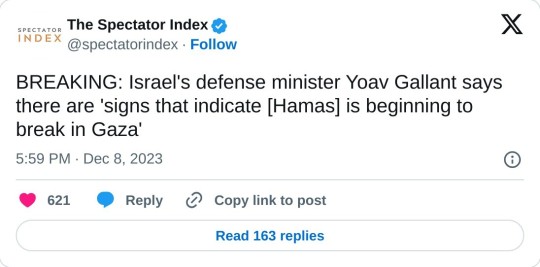
Every few weeks, Israeli officials say that Hamas is 'starting to break' or 'starting to lose control over Gaza.'
Meanwhile Hamas released a very slick trailer unveiling a new missile type, the M-90, that it used on Tel Aviv
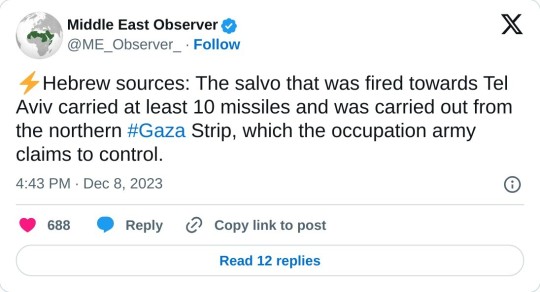
Al Qassam Brigades released a video showing their operation and it's the most intense one yet. Tw: explosions, gunshots, no blood or gore
Al Qassam has also released a video related to the tweets below and it's grizzly. Some of the special forces team and the POW were killed in the attempted rescue (though you only see the POW's body)
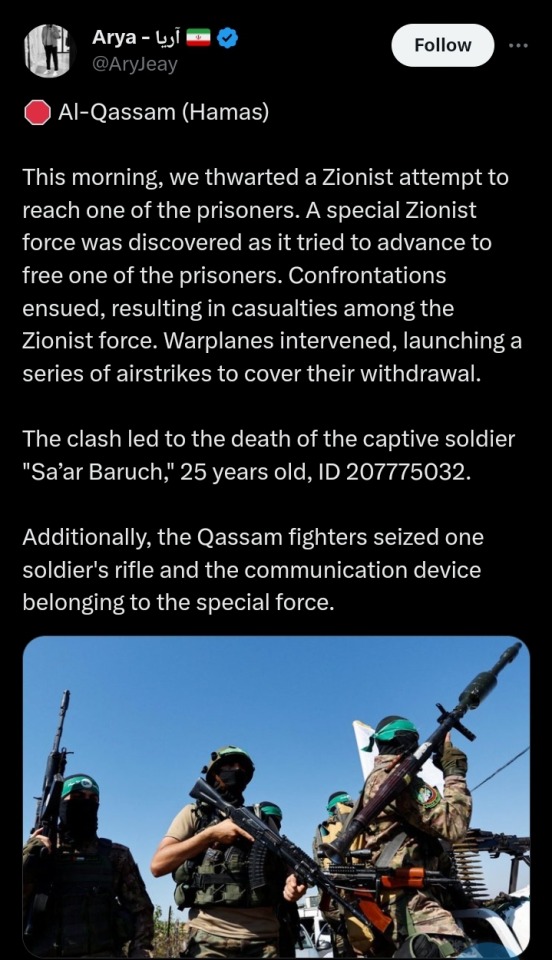
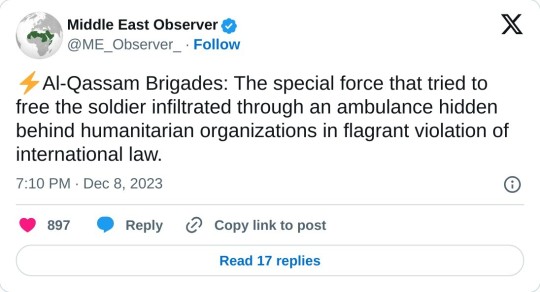

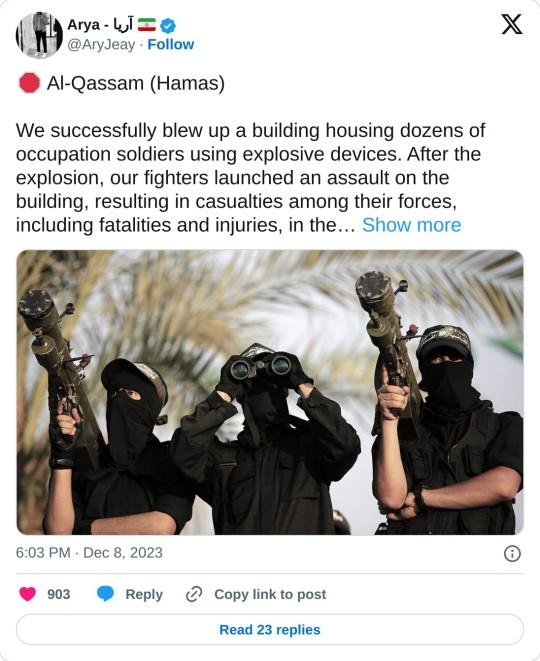
[CONT] eastern axis of Khan Yunis.
It's not just Al Qassam Brigades, the Al Quds Brigades has also released a video showing their fighters carrying out attacks against the IDF. It included a moment where one of the fighters shoots an RPG at a tank and then leaps for joy shouting ' It's on fire! It's on fire!'
Same TW as the Al Qassam video
The Mujahideen Brigades also posted an update
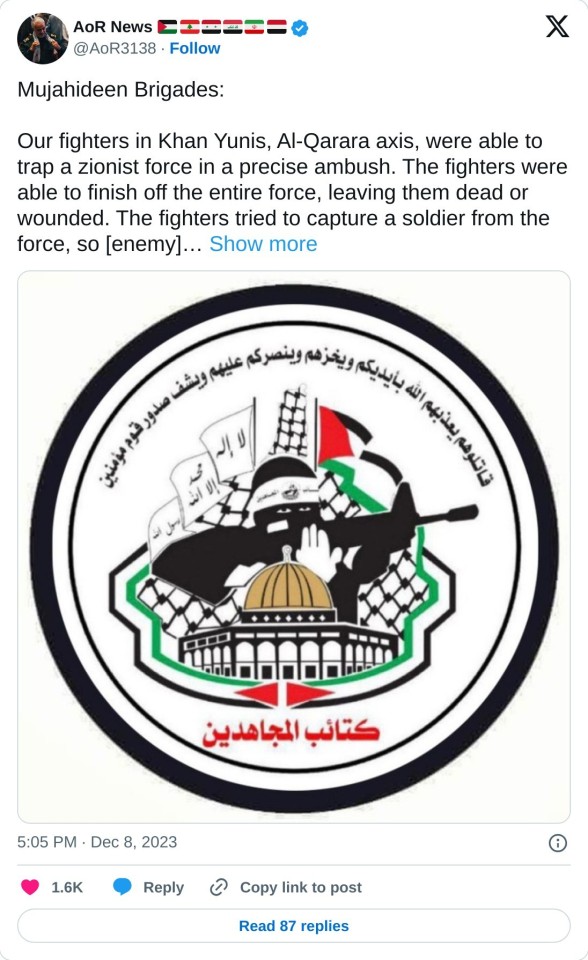
[CONT] aircraft intervened to bomb the soldier, and our fighters returned to their bases safely
Nasser Salah al-Din Brigades has spoken about one of their military operations in Gaza
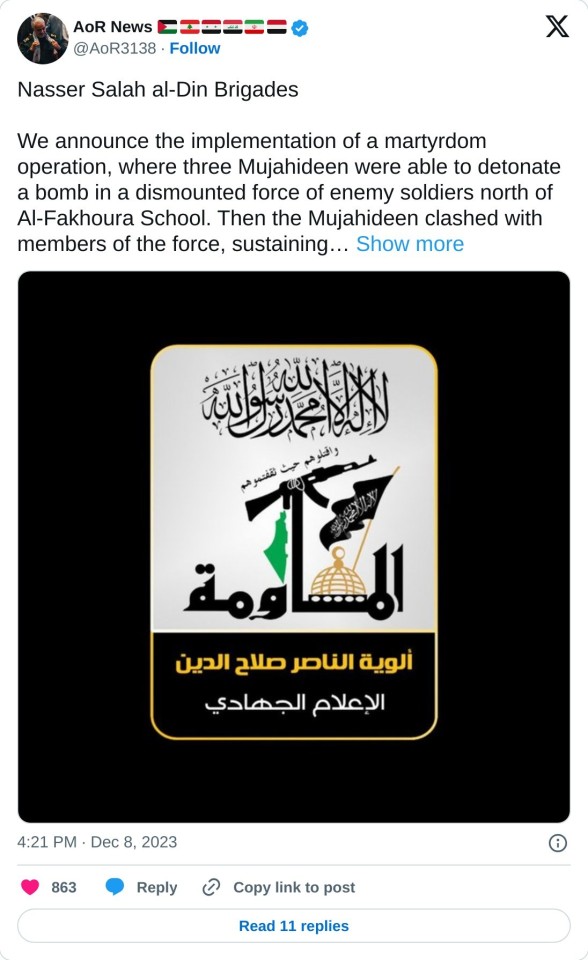
[CONT] certain injuries among them. One of the martyrdom fighters rose in the operation, and two of the heroes withdrew safely
It's actually really hard to keep up with everything that is happening in Gaza.
It has also been very intense in the other fronts too - namely Hezbollah at the Lebanon border and militia groups in Iraq and Syria
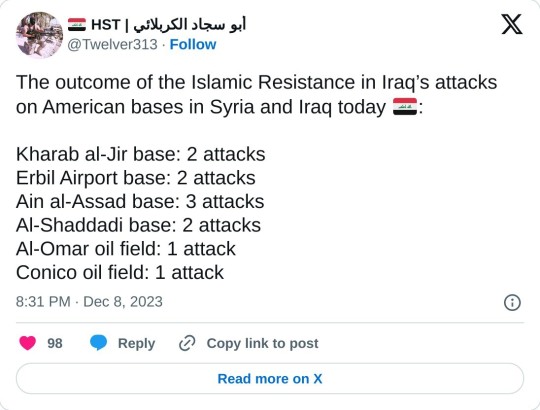
Btw a bill meant to withdraw 900 US troops from Syria failed to pass to expect more operations like this as long as Gaza is being destroyed.
#yemen#jerusalem#tel aviv#current events#palestine#free palestine#gaza#free gaza#news on gaza#palestine news#news update#war news#war on gaza
665 notes
·
View notes
Text
[ GERAÇÕES ]
Os seres humanos que despertam as habilidades de segunda ou terceira geração, sem se tornarem indivíduos de fogo geralmente tornam-se bombeiros (não sendo uma regra). Ademais, há três gerações de combustão, sendo elas:
O1. A Primeira Geração também chamada de Indivíduos do Fogo (ou infernais) são vítimas da combustão fazendo com que seu corpo inflame espontaneamente e os transformem em demônios destruidores. O processo até que se chegue a um Indivíduo do Fogo é doloroso para a vítima. São considerados um perigo iminente para a vida humana e para o mundo. Os bombeiros ficaram encarregados de extinguir esse mal e purificar suas almas. Esses indivíduos transparecem de uma forma negra envoltos de chamas perdendo qualquer característica humana anterior. Sendo mais difícil de acontecer mas não imposs��vel caso alguma pessoa tenha um um forte apego à vida ou uma grande força de vontade, eles podem manter a sua autoconsciência, no entanto, o nível de consciência difere entre os indivíduos. Eles podem lançar bolas de fogo e controlar as chamas de seus próprios corpos, mas também ganham um notável aumento de força e agilidade após a sua transformação. A intensidade dos seus poderem variam, podendo absorver e redirecionar as chamas em torno deles. A única maneira conhecida de matar um Indivíduo de Fogo é empalar seu núcleo, localizada em seu peito, que é um método indolor de devolvê-los ao fogo incontrolável.

#gerações#fire force#promo fire force#rpg br#rp br#indivíduos de fogo#infernais#fire force rpg#rpg#rpg brasil#rp#fantasy rp#primeira geração#1G
1 note
·
View note
Text
Writing Ideas: Fantasy Settings

Fantasy settings - the locations where fantasy series, novels, short stories, and movies take place.
Ways to Create Fantasy Settings
Place modern concepts in a medieval setting. George R.R. Martin had great success inserting thematically modern storylines into his vaguely medieval fantasy series, A Song of Ice and Fire. Try your own version of this by thinking up a fantasy story idea that feels contemporary yet is set in a medieval world.
Envision a quest that crosses many terrains. The quest is a classic fantasy trope, and it remains ripe for innovation. Use a quest narrative to think up a fantasy world that incorporates many settings, each with its own unique geographic flavor. Think about how the setting will impact your protagonist's quest both for good and for bad.
Head to outer space. To get creative with outer space, pick a setting that breaks the known laws of physics, incorporates aliens, or forces its human inhabitants to adjust in an extreme way. Imbue your your sci-fi fantasy setting with myths and a deep lore.
Dip under the sea. Underwater settings are popular in the fantasy genre, but not nearly to the degree of medieval worlds, dystopian future cities, or distant planets. As you pick an underwater setting for your novel or screenplay, decide whether your characters will be regular humans or whether they're amphibious creatures that can breathe underwater. Like all fantasy settings, an underwater world is a great vehicle for character development, so make sure to build out your protagonists and antagonists at the same time you embark on world-building.
Examples of Fantasy Settings
Middle Earth: J.R.R. Tolkien set The Lord of the Rings trilogy in this land resembles a pre-historic Europe filled with mythical creatures like dwarves, orcs, and wizards.
Westeros and Essos: These two lands comprise the setting of George R.R. Martin's A Song of Ice and Fire series, which takes a page from Tolkien's high-fantasy world. Martin's books, and the TV series it inspired, Game of Thrones, overlay real-world motivations like lust and power atop a mythical domain filled with dragons and White Walkers. It’s a place where people take magic as a given.
Narnia: C.S. Lewis set The Chronicles of Narnia in a fantasy world that children can reach. This is established in the first book in the series, The Lion, the Witch, and the Wardrobe. In this sense, Lewis distinguishes himself from his English contemporary Tolkien by intentionally merging the real world with a fantasy land.
Roleplaying games: Sometimes the best fantasy settings are those created in real-time during a roleplaying game (RPG) like Dungeons and Dragons. In D&D, the world is filled with wizards, dragons, elves, orcs, and mystical clerics. Many games involve epic clashes of good and evil in lands reminiscent of medieval Europe, but the exact course of a game will depend on the decisions of the people playing it.
High Fantasy vs. Low Fantasy
In high-fantasy storylines, the entire world is constructed and clearly operates differently than the world we know. High-fantasy worlds may resemble certain areas of earth at specific periods in time, but their laws of physics and cultural customs are unique.
Low-fantasy stories are set in the real world as we know it but incorporate magic or other fantastical elements.
Fantasy settings tend to bend the rules of real life.
Some fantasy settings recall eras past, such as steampunk novels set in Victorian England or epic fantasies that recall medieval Europe.
Other fantasy books and movies use futuristic sci-fi settings that incorporate spaceflight, time travel, and other tropes of science fiction.
Meanwhile, dystopian urban fantasies often take place in post-apocalyptic settings.
In classic fantasy books and fairytales, the fantasy settings enable the main characters to grow and evolve.
Source ⚜ More: References ⚜ Writing Resources PDFs
#fantasy#worldbuilding#setting#writing tips#writeblr#literature#writers on tumblr#writing reference#dark academia#spilled ink#writing prompt#creative writing#writing inspiration#fiction#writing ideas#light academia#on writing#writing advice#writing resources
122 notes
·
View notes
Text
Welcome to another round of W2 Tells You What You Should See, where W2 (me) tries to sell you (you) on something you should be watching. Today's choice: 琅琊榜/Nirvana in Fire.

Nirvana in Fire is a 2015 historical series best described as either a complicated succession drama set in the premodern Chinese imperial palace, or the story of a man who didn't die a decade ago and has decided to make it everyone else's problem.

And really, I almost feel silly giving my glib little summary, because Nirvana in Fire is so well-known of a property. It's a classic for a reason, and that reason is that it's legitimately very good. This show is what happens when you adapt a solid story, get a bunch of very talented actors, and throw a huge amount of money at it. It's incredibly popular and highly acclaimed, and it earned all of the hype.
Still, while I bet there are few people adjacent to c-drama stuff who've never heard of Nirvana in Fire, I'm sure there are plenty who haven't watched it. After all, it looks like one of those slow, serious shows with a lot of ponderous talking and no joy. If that's the impression you've been given, I could imagine looking at the 54-episode commitment and saying, I don't need that in my life.

I am here to tell you you're wrong. It is a banger of a show. It's tense. It's funny. It's heartbreaking. It’s exceptionally clever. It’s jaw-droppingly stupid. It’s romantic. It’s tragic. It has smart plots and bizarre subplots. And that's not even touching the thing with the yeti.
So in case you're one of those people who's heard of Nirvana in Fire, but has put off watching it for one reason or another, I'm here with five reasons I think you should try it.
1. Epic Shit
Did you like the Lord of the Rings? More specifically, did you really like the second Peter Jackson film? Great, then you're all set for this.

I guess I could have called this Game of Thrones without the dragons, but that's not actually the vibe at all. Game of Thrones is much more sensational and salacious, with all the blood and butts and what-not. The Tolkien comparison is more apt, I think, because Nirvana in Fire is equally about as wholesome as you can get in a property where dudes are still getting stabbed all the time.
This is a show about vengeance. And yeah, justice for the fallen, sure, that's fine too. But mostly it's about a bunch of good people joining forces to make sure the bastards who did wrong pay, with their lives as necesary.

The problem, though, is that these bastards are incredibly powerful, which means that a pure brute-force approach isn't going to work. Accordingly, this quickly becomes a story about the power of smart teamwork to exact retribution on some people who can (and did!) legally get away with murder -- and our heroes are some of the people with their necks most on the line if anything goes wrong.

Don't let the Middle Earth comparison fool you into thinking this is all epic swordfights. It's not. (I mean, for one thing, as well-funded as this project is, it doesn't have Peter Jackson Money.) The vast majority of the tension in the show comes from dialogue and slow, terrible realizations. The fight scenes are almost a relief from the nail-biting intensity of intimate conversations about getting a letter from somebody's ex-wife or returning a book.
All told, the show has that incredible almost-RPG vibe of going through all the little subquests and cutscenes you find along the way to defeat the final boss. The plot carefully unravels a multi-tendriled mystery told to you by people in incredible costumes. It doesn't get much more epic than that.

(Nirvana in Fire is also a cautionary tale about how you should be very careful with who gets invited to your birthday party.)
2. A chronically ill protagonist
Okay, right in the first episode, it is established that the main character has three whole completely different names and an old nickname. I'm going to call him Mei Changsu for the duration of this rec post, but let the record show that I could just have easily gone with one of the other three.
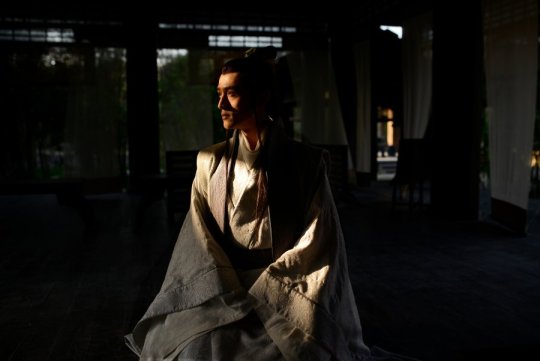
What you learn in that same first episode is that Mei Changsu used to be a palace insider, the cocky son of a noble family, only now nearly everyone he used to know thinks he's dead. Also, he's not far off from being actually dead -- he has an unspecified terminal condition that's mostly managed, provided he stays in his little mountain hideaway with his handsome doctor bestie and doesn't return to his old stomping ground and start kicking over hornets' nests.
So guess what he's about to do.
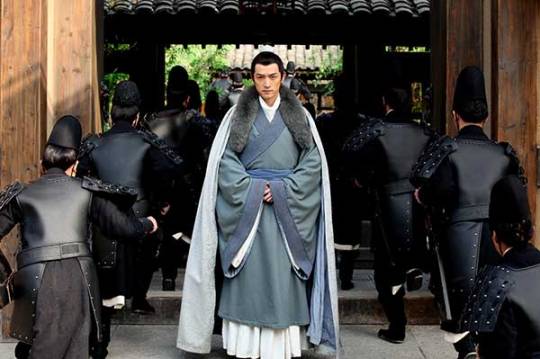
I have to make a note of how brilliant the casting is here: Hu Ge is an action actor! He is a kickpuncher of a man! And I think it's great that you can sort of see his frustration, as well as Mei Changsu's, at having to spend the whole series wrapped in countless layers of fabric and/or lying in bed while everyone around him gets to be the badass action heroes.


Mei Changsu's not faking it, either -- he's actually dying. He expends his energy where he thinks it's necessary, and sometimes that means he has to spend the following week in bed. He's constantly frustrated with himself for what he can't do anymore. He's racing a clock, and that clock is his own failing body. If he dies, the only hope anyone here has for justice dies with him.
He gets two love interests that the show treats pretty much equally. One's a lady general who wasn't even a love interest in the book. The other's the handsome prince who was initially going to be his textual romantic partner in same book, until the author hopped genres from danmei to general historical drama. I can't even call this a love triangle, because there's no competition. He just gets a wife and a husband -- in that he gets neither, because circumstances and his own illness keep him distant from them. He lies to both of then about his condition (among other things). He wants to be with them both and knows he can't be with either. And they in turn have to learn to accept what of him they can and can't have.


(Also, Nihuang (her) and Jingyan (him) are both incredibly gorgeous, which is exactly what bisexual genius Mei Changsu deserves.)
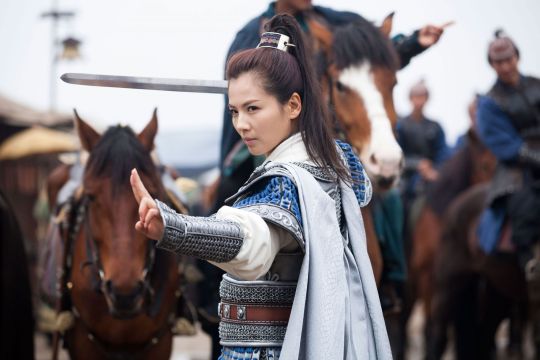

Obviously this isn't a perfect representation of life with chronic illness, largely because Mei Changsu is an incredily wealthy man who lives in a universe with what's basically magic medicine. However, I've seen the story's treatment of him and his condition resonate with a lot of chronically ill viewers, so even with the fantasy layer on it, there's definitely something there.
3. Dave
I have already told the story of how Meng Zhi became "Dave," but long story short, he's such a Dave that I legitimately forget his character's real name. He embodies Daveness. He's The Ultimate Dave.
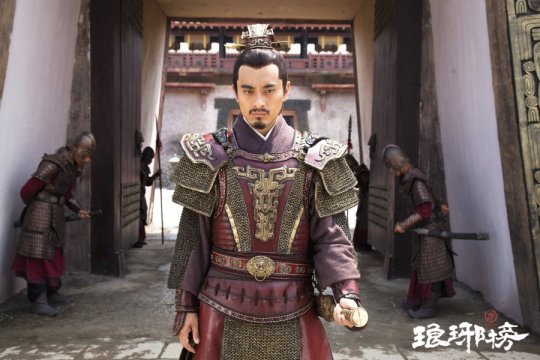
Dave is an excellent fighter, a loyal friend -- and a terrible liar. He's possbly the only straightforward character in the entire show. When he's asked to be duplicitous, he's comically bad at it. Dave will never do a heel turn. I was misled at first by his semi-evil facial hair, but I have seen the error of my ways. Dave is pure lawful good.
And the reason I list Dave as such a selling point is that having a Dave means you always know what's going on. This is because Dave never knows what's going on, and he has no ego about that, so he asks questions, and other characters have to explain to him what just happened, and that is how you figure out what's going on.
It's an incredibly smart move on the drama's part, because some of the (very fun) schemes are so complicated that there's no way for you, the viewer, to understand them just by watching. Without the internal monologues and omniscent narration of a book, the machinations are opaque. You need things explained -- but why would the schemers explain their schemes? Well, Dave needs some exposition, so here you go.
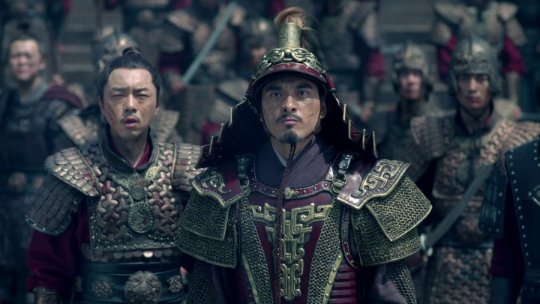
So if you're worried that you might be left feeling stupid by a show where so many sneaky people are hatching so many complex plans, worry not! Like the good man he is, Dave has your back.
4. A Million Amazing Antagonists
If you like bad guys, this is a show for you. This show has brilliant bad guys all the way down. It has bad guys at every turn. It has bad guys for every taste. Welcome to Big Liang's Big Bad Guy Emporium, where we guarantee you'll walk out of here with a bad guy you like, or your money back!
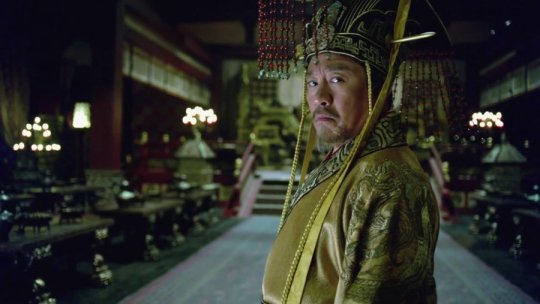



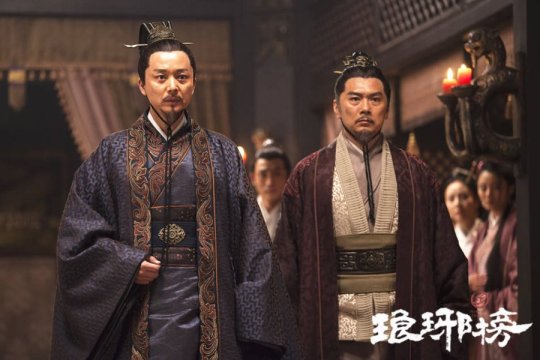
(And yes, this set of pictures is also to say that their costume budget was entirely well-spent.)
Without getting too far into spoilers, I will say that the basic situation underlying the whole series is this: The emperor has done a lot of bad things, and he has enlisted a bunch of people's help in hiding those bad things, so much so that many of those other people have done even more bad things the emperor didn't even know about -- and then everyone has gone to great lengths to cover those up as well. Our protagonists spend the whole series unraveling this colossal shitshow and bringing people to task for their crimes.
So really, if you're going to spend 54 episodes taking down the baddies, they've got to be baddies you love to see taken down. And these are -- in part because all of them have crystal-clear, rock-solid motivations for their actions. Nobody here is a moustache-twirling comic-book-villain baddie. They're all bad for reasons that are very understandable in their individual contexts. And not a single one of them is going to go down without a fight.
5. World's Best Mom
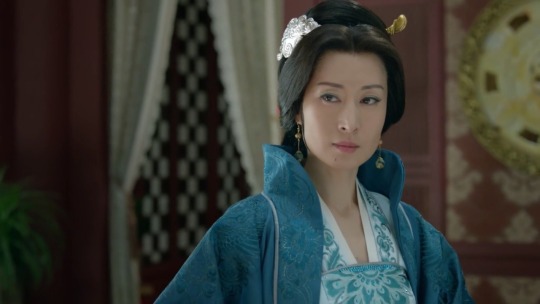
(Sidebar: The fact that four out of five of my reasons to watch the show are individual or groups of characters should be your strongest indicator that this is an intensely character-driven story.)
This is not a Dead Mom Show. Okay, some moms are dead, but mostly this is a Moms Are Alive And Often Cause Problems Show, which is a lot of what makes the palace drama so delicious. But there is one Good Mom who stands out above all the rest: Consort Jing.

Played with perfect grace and devastating politeness by the stunning Liu Mintao, Consort Jing is a skilled doctor and excellent baker who starts the show with a low-level status among the women of the palace. She swallows down all kinds of mistreatment because she's not in a place to oppose it -- and when she can retaliate, it must only be through soft power. She loves her jock son with all her heart, but because of both their relatively poor positions in the hierarchy, she doesn't get to see him all that much. She wants to be an asset to him, while all the time she has to fear becoming a liability.

She is also the smartest person in any room that she's in, unless she's in a room with Mei Changsu, and even then it may be a tie.

There are lots of great characters in the show that I could have highlighted here, and plenty of them are women, but Consort Jing in particular never ceases to impress me. She is trapped in a gilded cage, married to a man who [lengthy list of spoilers that are traumatic to her in particular], and held hostage by how every time she even looks like she's out of line, it puts both her and her boy in danger. She's the most vulnerable of any of our good guys. Kind of like Wang Zhi, she's got to be clever or she's dead.
Consort Jing is not part of Mei Changsu's original plan. She figures out his plan and makes herself part of it -- and entirely remotely, as she and he aren't even in the same room until episode 40 or so. She puts herself in great danger to make sure he succeeds, not because it will necessarily do her any good, but because Jingyan needs him. This woman has been captain of the Mei Changsu/Jingyan ship for like twenty years already.
Oh, and did I mention her outfits?

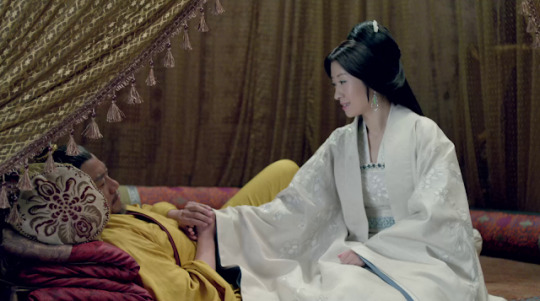
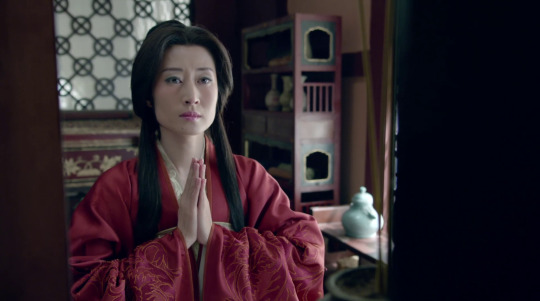
I love you, Consort Mom.
Are you ready to watch it yet?
Get it on Viki! Get it on YouTube! Get it on YouTube but in a different playlist! (And also maybe get it on Amazon? Not in my region, but maybe in yours.)
I will warn you that it does take off running -- I think I saw someone say it introduces nineteen characters in the first episode? I was worried that I'd be too innundated by situations and flashbacks and names to be able to follow. By the second or third episode, though, I was rolling with it. So if you feel like you're struggling at the beginning, stick with it a bit. See if you don't feel it start to click.
...Man, reading over this post has left me going, oh, but I missed that! and that! and that guy! And yeah, the truth is that there are just so many great things about the show that limiting myself to only five (and being limited to only thirty images) was tough. I'm sure that people reblogging will add their own must-see elements.
Truly, this is a show that deserves its reputation. It may not be for everyone, but if this is the kind of thing that you like, it is a shining example of that thing.

Besides, you have to love a production where everyone was clearly having just a whole lot of fun being big ol' costumed dorks.
498 notes
·
View notes
Text
GENERATION KILL - MILITARY TERMINOLOGY AND SLANG USED IN THE MINISERIES (Part 2, N-Z)
N.J.P. (Non-Judicial Punishment): next to a court martial, the most severe form of punishment to which a Marine can be subjected. It usually involves a loss of rank and pay grade.
Navy Hospitalman, Doc Bryan: the medic, though medics in the Marine Corps are technically part of the Navy’s hospital corps and are never referred to as “medics” but as Corpsmen.
Negligent Discharge: accidental firing of a weapon; aka N.D.
Nine-lines: a procedure for directing air strikes on ground targets.
No salute zone: forward areas where officers are not to be acknowledged with salutes, in order to conceal rank from potential enemy observers.
O Dark Hundred: until darkness falls. Note: “O dark 30” typically means half an hour before dawn, or any ridiculously early hour of the morning.
Oakley sunglasses: surfer sunglasses worn by just about all Marines in Iraq. Iraqis believe Oakleys give Marines X-ray powers to see through women’s clothing and are a constant source of tension.
One M.E.F. (First Marine Expeditionary Force): the overall Marine invasion force in the Middle East, which comprises the First Division (ground troops) under command of Gen. Mattis, the Air Wing and a logistics battalion. The entire One M.E.F. is under the command of General James Conway.
Oscar Mike: “On the Move” from the phonetic alphabet.
Overwatch: a position that offers protective fire for a given area.
“Paint me”: to paint something is to shine one’s gunsight laser designator on a target in preparation for shooting it.
PAS-13 Thermal: a night vision device, about the size of an old video camera, that can see heat signatures. Note: A single device is usually referred to in the plural, e.g. ,“Pass me the thermals” refers to one device.
Pec-fours, Pec-thirteens: night and infrared vision scopes.
POG (Person Other than Grunt): a pejorative term for anyone who is in the rear echelon and therefore not in a recon or infantry unit. This is one of the most insulting terms in the Marine Corps, almost the equivalent of the “N” word. Note: POG is pronounced with a long “o.”
Police: to clean up or correct, as in “Police your tent,” or clean it up. (1-16)
Psy-Ops: Psychological-Operations units, which in Iraq relied on leaflets, radio and loudspeaker broadcasts to encourage enemy forces to surrender.
Pyro and Smoke protocol: codes involving use of smoke grenades and flares.
R.C.T. (Regimental Combat Team): a super-regiment of about 7,000 Marines; the First Division consisted of three RCTs – RCT 1, RCT 5 and RCT 7 – plus First Recon, which operated on its own.
R.C.T. One (Regimental Combat Team One): a motorized, armored infantry regiment of about 7,000 Marines.
R.O.E. (The Rules of Engagement): the all important, ever-changing and always ambiguous rules governing when a Marine may fire his weapon.
R.T.O. (Radio Transceiver Operator): radioman, the most important guy on the team and usually the calmest and smartest next to the team leader. (1-23)
Rack: nautical for sleeping area.
Ranger Graves: sleeping holes dug by marines to protect from shrapnel and gunshots.
Raptor: radio call-sign for First Recon’s Charlie company.
Recon Mission: a reconnaissance mission performed specifically by Recon Marines who are the Marine Corps special forces; there are only a few hundred Recon Marines in the entire Corps.
Red-Con One: a loaded weapon with a round in its chamber, but with the safety on.
Revetment: crude fortifications made from earth or concrete or sandbags.
Ripped Fuel: brand name of a popular over-the-counter stimulant, banned by the military but widely used.
RPG (Rocket Propelled Grenade): anti-tank rocket first developed by the Germans as the “panzerfaust,” then adopted by Soviets and as common to Iraqi forces and insurgents as Skittles candies are to Marines. Not very accurate, but devastating when fired in mass by five- or ten-man RPG teams. RPGs were famously used to bring down U.S. Army Blackhawk helicopters in Somalia.
S.O.P. (Standard Operating Procedure): S.O.P. is sometimes informally used as a synonym for common sense.
Saffwon Hill: a low hill on the Iraq side of the border with Kuwait, believed to be the locale of a dug-in Iraqi division.
Sapi plates: 12-inch square ceramic plates worn in front and back of one’s flak vest, rated to stop the enemy’s preferred 7.62 round.
Schwack: to kill; origin believed to be a popular video game.
Screwby: either “That sucks,” or “That’s really cool,” from Cpl. Stafford’s personal hip-hop lexicon.
Senior NCOs: anyone from staff-sergeant to Sergeant Major. Corporals and Sergeants are also NCOs, but they are never referred to junior NCOs, simply as NCOs. (1-18)
Sergeant Major: the highest possible rank a non-commissioned officer can earn in the Marine Corps; invariably a ball-buster who speaks in a semi-illiterate southern sounding accent no matter where he is from. This battalion has just one Sergeant Major.
Shamal: hellacious wind and dust storms endemic to Iraq.
Sit-Rep: situation report:; often used as a more confusing way to say “situation.”
Skittles: chewy fruit-flavored children’s candy, which is a dietary staple in U.S. military.
Slackman: team machine gunner, armed with a SAW.
Snatch: a specific Marine term for abducting an enemy combatant in order to gather intelligence.
Soft Cover: same as a boonie cap. Note: the word “hat” does not exist in the Marine Corps; anything you place on your head is a cover.
Sparrow: a small reaction force held in reserve while another unit attacks; an “eagle” is a large reaction force.
Spread load his excitement: to calm down; from the tradition of foot patrols spreading a heavy load equally among all troops.
T-55: Soviet-era tank ubiquitous in Iraq; older and much less feared than the newer, but less-common T-72 Soviet tanks also in Iraq.
TAD-two, TAD-three: Tactical Air Direct radio bands for communicating directly with pilots in attack aircraft.
Task Force Tarawa: a four thousand-strong Marine unit outside of the First Division Command Structure. This American unit was initially put under the command of the British at Basra, then moved north to Nasariyah.
Team Leader: the sergeant in command of each combat team. Fick’s platoon is divided into three teams, but spread across four Humvees (not counting Fick’s command vehicle, the fifth Humvee). Since Fick’s platoon is a special forces unit trained in coastal raids, they have no experience with Humvees. Technically each team has a specialty, with team one being the dive (or SCUBA) team, team two being the boat team and team three the para-jump team. But here, ironically, they are all in a desert.
The Three: the battalion’s intelligence unit.
T-rats: T-rations; pre-manufactured military food heated and served in mess halls of forward units.
Triple-A: Anti-Aircraft Artillery; towed or self-propelled guns designed to shoot down aircraft but often used by Iraqis against American forces on the ground.
Two o’clock: direction of enemy forces. Orientation of the lead vehicle puts 12 o’clock at the center of the hood and six o’clock at the rear.
Two-Oh-Three: an M-203 grenade launcher, which is a single shot self-propelled weapon mounted beneath the barrel of a standard Marine rifle. The M-203 fires the same 40mm round as the M-19.
Unfucking: a verb peculiar to the Marine Corps meaning to get out of a fucked-up situation.
U-two: a reference to venerable U2 spy planes.
Victors: vehicles. The military uses the phonetic alphabet as a shorthand code: the phonetic alphabet replaces letters with words, i.e., Alpha, Bravo Charlie, Delta, Echo. These phonetic word for each letter of the alphabet can be used to replace any word starting with the corresponding letter. Hence, vehicle becomes “victor,” terrorist becomes “tango” and white trash becomes “whiskey tango,” as in, “He grew up in a whiskey tango trailer park in the Ozarks.”
Whiskey Tango: white trash, from the phonetic alphabet version.
Zil truck: Russian-made truck popular in Iraq.
59 notes
·
View notes
Text
On Posture In Gubat Banwa
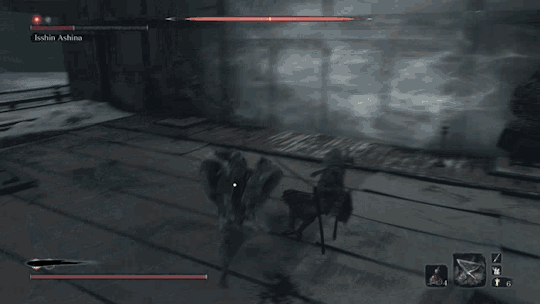
So the sixth version of Gubat Banwa's First Edition "returns" to the ideal that HP as a pacing mechanic, an Action Economy limiter, and a resource pressure. As always, in Tactical Combat games, resource management is a major aspect of the gameplay. Management of action economy, management of distance, management of other currency (such as Class-specific Resources). Most of a Tactical Combat Grid game revolves around the manipulation of these mechanics: reducing, regaining, adding, changing, force multiplication/division of these resources, and more. In Tomian Design (that is, Tom of LANCER RPG and ICON RPG), costing.

For the first 5 versions of Gubat Banwa's design, we worked with lower HP values (across the board) and with Dice Pools. The idea was that each dice in a dice pool was an attack launched, or a moment of concentration. Every die in the defense pool was a parry or evasion attempted. While the fantasy of that worked pretty great, the maths on the other hand did not. It worked almost counter-intuitively against the high-flying martial arts x deliberate tactical combat that I was trying to strike a balance for. My white elephant, my Shambhala, was to strike a good balance between that.
The Change
In 1.6, while the Dice Pool didn't entirely go away--much of the game is built around getting tactically advantageous positions so that you can get more dice and a higher chance of dealing greater damage on the target--it went for a more linearly scaling game with the result on the die reducing the target's Health.

It was a hit, mostly, among the inner circle (that is to say, my friends that I run the newer version for). There was an immediate sense of "we know how this game works" now.
On Tactical Video Games
It was more transparent--this information was crucial to making a tactical game work and sing. This is why in video games, almost every tactical game has the "Combat Forecast", like in Fire Emblem and Final Fantasy Tactics, that showcased the expected Hit Rate and the Damage Output.
This is absolutely integral: tactical games are decision point games. Without the proper information (doesn't need to be complete information), no decision can be done satisfyingly. This isn't to say that dice pools can't be used for a tactical game of course--I've done it. But it requires a different kind of design principle and design goal that Gubat Banwa wasn't going for. That sense of martial progression, of spiritual strength and eventual enlightenment.

From HP to POS
During the initial playtests, we were still working with HP. Hit Pearls. The idea was that every hit "shattered" a Hit Pearl. This worked with the Dice Pools, because the fiction was that every attack could be parried with Defense Dice.
What was the problem with this? Firstly, the math of this was inherently fraught, unfortunately: on higher levels, Defense Dice were either horribly impenetrable or did absolutely nothing to defend you. It became a binary thing. That was not the goal: for the martial fantasy to come to life, much of the decisions should not binary but rather, on a gradient spectrum.
To me, the destroyer of tactical grid games is when there's a single best strategy that shatters the tension of the game. My favorite parts of Final Fantasy Tactics and Tactics Ogre were early game moments where the output randomness could make every fight go completely different, even if you redid the same stage more than once.
Secondly, when the outcome of an action is that, really, nothing happened, you used an attack (even worse, the attack was buffed by yourself, an ally, and tactical modifiers) and then the target was able to parry all your hits. The fiction is exciting for a second, but then when you return to the battle grid, nothing changed. The mechanics fed into the fiction, but the fiction didn't feed into the mechanics.
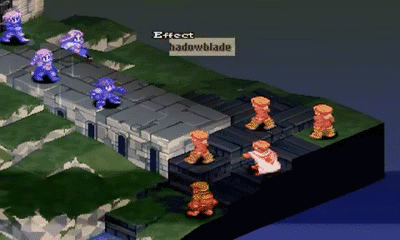
With the math change, the fiction of the Hit Pearls wasn't working because HP values were higher to compensate for the changed math. 12 Hit Pearls could feasibly be visualized as Link's Hearts, for example. But at 48 HP, that didn't work anymore.
Hearkening to the Ancients
So I actually went on a trip to older versions of Gubat Banwa, and found I'd solved that particular problem. Older versions of Gubat Banwa had HP as "Mettle", their ability to stay in the fight. Turning to the game's current version, I realized the Physical Defense stat was perfect: POSTURE. The stance, the guard, the ability to keep fighting, the ability to turn mortal wounds into grazing hits, the ability to ignore the effects of bleeding wounds, of burning pyres, of seeping poison.
Every attack was inflicting damage by chipping away at the target's guard, or forcing their stance into more compromised positions so that they would be open to an actual mortally wounding strike. They were still real hits that the defender was actively still guarding against. And with every attack defended, their guard wore down.
This hit me after watching Donnie Yen's SAKRA (2023) the other day. Reaching back into the high-flying wuxia roots, Donnie Yen's character doesn't even take real hits until after he's overwhelmed because he is such a martial superior against the rest of the Beggar Clan. Because his Posture was so high.

Ten Thousand Earth Shattering Blows
It worked great. Not to mention that it's a great reference to Sekiro, another huge inspiration to the games's intended fiction, which also had a Posture break. Now Staggered for half Posture or lower made sense: your guard is brittle! You court death! Now the Wide Open affliction felt more in genre: your guard is wide open, so you're suffering more!
The Physical Defense stat was renamed into PARRY, while the Magical Defense stat was kept as RESILIENCE (itself a reference to Final Fantasy Tactics A2!) The defenses were there to keep the mechanical bite of an Attack vs Defense interaction, to provide an avenue for another mechanical design space, as well as to shoe in the fact that when an attack targets your Parry you're physically blocking while an attack against your Resilience requires your fortitude and concentration to block against: when your Posture is reduced, when you guard is worn down by these attacks, you know how you were defending.

When enemies hit 0 POS, that attack is the one that gets through their Defenses and kills them outright. When a Kadungganan falls to 0 POS they're not dead, but they suffer a WOUND, which only heals on Downtime (as opposed to POS healing on Repose, ie., short rest).
On Defeat and Victory
While you're Defeated, you suffer the same effects of Stun, but you can still act and do things, even make attacks at full power: you're Kadungganan after all. But every attack against you, despite your PARRY or your RESILIENCE is not met with a stance ready to block. Thus, every instance of damage you suffer, no matter how much, inflicts another Wound. When you eat 5 Wounds, you can pull on your Conviction to stay alive. Otherwise, you are tossed back into the cycle of reincarnation, or into the river to Sulad, or to Lunar Heaven, or to whatever next life your Kadungganan has chosen to ascribe to.

Status Effects
Statuses such as Poisoned, Bleeding, or Aflame, don't break you yet because they must eat through your bodily resistance. But they are still real: an aflame Kadungganan fights on even as flames swathe their body.
They can die later, when they feel the effects of the burn when their POS falls to 0. They can die later, when the Poison finally seeps through and enervates them and destroys their defensive capability. They can die later, when the bleeding takes its toll and they can no longer keep their stance up.
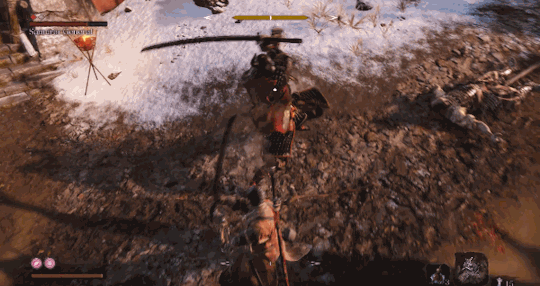
Martial Glossolalia
With a simple terminology change, the fiction changed entirely. Now everyone knew it was their defenses wearing down. Swords didn't cut off their fingers, flames didn't burn through their skin. They know that defenses are a holistic thing: your stamina, your constitution, your composure, your reactive ability, your dexterity, your presence of mind, your focus.
"It's not realistic!" The game is not meant to be realistic, and realism is not an inherent ontological good nor is it a goal for most TTRPGs, you will notice. Experiences, feelings. The fiction Gubat Banwa draws upon--SEAsian Folk Epics, Asian Martial Arts Cinema--is filled to the brim with the CLANG CLANG CLANG of sword-on-sword action. Often these clangs happen so quickly that you cannot process them, they are abstracted to you when it resolves in your brain--so is it abstracted by Gubat Banwa. Posture going down is the CLANG CLANG CLANG that resonates across a fight scene. It's not realistic because it's not meant to be, and even then, we must argue what your conception of reality is!
I could be argued that much of Tabletop RPGs (and, I would argue, most of games in general) is an exercise of language. Exploiting its vagaries, its ability to connect. When you go into Gubat Banwa, learning the mechanics of the game is learning a new language. And what is language but the foundation of culture?
309 notes
·
View notes
Text
Wife Goals: Edelgard von Hresvelg
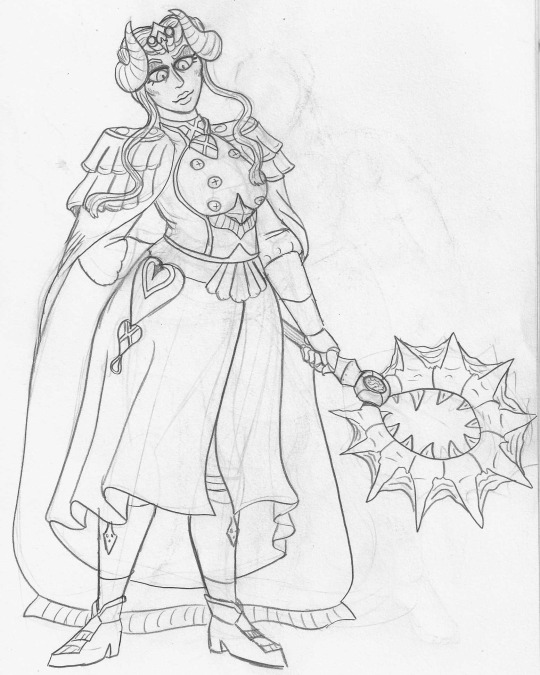
Alright gang, after covering Morrigan from Dragon Age Origins last time, it's time for another RPG gal here on Wife Goals, the emotional breakdown masquerading as a series of personal essays that I swear won't go more than seven entries! I swear! It's going to be video game ladies from here on out actually, both because the interactive nature of that medium makes it REALLY easy to form these unhealthy parasocial attachments to fictional ladies, AND because it's the most socially acceptable way to project your desire for romance on made up people! Huzzah for video games! Huzzah!
I don't remember exactly why, but I was in a bad headspace when Fire Emblem: Three Houses came out. It was probably just the normal "why have I accomplished so little in my life why am I still alone oh god I've wasted my time on earth" thing that's always gnawing at my brain, IDK. What I know is that the void inside me was GNAWING and I needed to fill it, preferably with something new, because replaying my age-old favorite RPGs, while soothing, would also feel... sad. You gotta try new things to trick yourself into thinking you're going somewhere, you know?
I had played Fire Emblem Awakening, and it was pretty good! Pretty fun, it had an evil witch in it who was romanceable, and that was fun. I didn't finish it, but I sunk a good few hours into it. I had also played Fire Emblem Fates and.... I shouldn't have! It's bad! It's basically Incest: The Game! Don't play it! So, you know, I didn't exactly have full confidence in Fire Emblem: Three Houses when I picked it up, but the gnawing void needed some new content, and if it was as good as Awakening, or just less incest-y than Fates, it'd scratch the itch for a bit.
Guys... Three Houses is so much better than Awakening. My void was eating GOOD that summer.
The conceit of Fire Emblem: Three Houses is that there are three nations who send their most promising young people (i.e. mostly the rich kids) to an academy located in the monastery of the Fantasy Vatican - by that I mean it's owned by the leaders of the church that forms the primary religion in all three nations. Each nation has its own "house" in the academy - fraternities, basically - and your Player character is a mercenary who's been more or less forced to be a long term substitute teacher for said fraternities despite being about the same age as the students. You're the honor student who's forced to play teacher by a struggling school district, basically, only if said honor student was hired because of their experience in killing bandits.
Which house you choose matters immensely, as the OTHER conceit of the game is that all those friendly college-aged students of yours are destined to inherit important political roles in a war that is beginning to brew, and when that war breaks out, you and your students are going to be seeing one nation's perspective in the three-way conflict that ensues. Those perspectives, or routes as they're officially called, differ DRASTICALLY, in part because the leaders among the three groups of students you have to choose from have vastly different goals they're trying to achieve. And one of those students is Edelgard von Hresvelg, heir to the Adrestian Empire.
The first thing you need to know about Edelgard is that she is heavily villain-coded, both in general and in the Fire Emblem franchise specifically. Fire Emblem is a franchise with so many entries that it has its own recurring tropes. There are specifically archetypes that recur a lot, and one of the most common is The Big Villainous Tyrant Wearing Red. They often lead a big, villainous empire that's trying to take over the world, as you do. And Edelgard's nation... has red on their banners. Edelgard's customized school uniform includes a red cape and red tights. And the title she stands to inherit is Emperor - i.e. a title that you specifically get by owning more than one nation, and it's stated that the Adrestian Empire used to own ALL of the continent before it was fractured to its current state, which is exactly the sort of setup that led past Fire Emblem villains to start world-conquering.
She is going to grow up into an empress in red. She's the Big Bad. Maybe not right now, but if you know the genre, and specifically the Fire Emblem tropes, you KNOW she's inevitably going to be the villain. Or at least a villain - often the Big Villainous Tyrant in Red is, in normal trope terms, The Heavy, i.e. the villain you fight the most, but not the FINAL villain. The Darth Vader, if you will, with a Palpatine who reveals himself towards the end.
This is why Edelgard's route is the only route that bifurcates - there is a crucial moment, the moment right before Edelgard proves she is very much the Fire Emblem trope you'd think she is, where you have to choose whether to stand with her or not. You can choose to side against her, and if you choose to do that, or to do either of the other two routes, then Edelgard is exactly the villain you think she is, and as such, you have to kill her before the game is done. And that's all she is - another Evil Tyrant in Red, an emperor to be slain, a villain through and through.
...but this is a game about different perspectives on a war, and wars are never black and white. They're messy, and the game is very good about showing that while most of the people in this conflict have good intentions, NONE of them have all of the facts, and none of them made completely perfect choices, in part because there were very few perfect choices to make.
We get to know Edelgard very well before the crisis moment in her route. As you'd expect of a royal heir, she has a lot of weight on her shoulders from the responsibilities that leadership will bring. But she also has weight from a lot of unexpected sources as well. She's tight-lipped at first, but it becomes clear that this young woman has some horrific trauma in her past - she keeps waking up with night terrors about rats trying to eat her, night terrors that you find out are suppressed memories.
Edelgard, it turns out, is not just a royal, but also the subject of the fantasy equivalent of horrible genetic experimentation. So were all of her brothers and sisters - the only difference is that Edelgard is the only one who survived. She spent her childhood being tortured physically and psychologically to make her stronger, all while watching the same things happen to her siblings until they died one by one. Her night terrors about rats come from the time she spent in dungeons with her dying siblings.
See, the magical fantasy world of this game has a society that buys into what is essentially fantasy eugenics - noble houses are marked as such because they bear "crests," i.e. magic powers that make them stronger and more durable than normal people, which can be passed down through familial lines. Crests are said to be gifts from the gods that the Church is devoted to, so the Church explicitly supports and provides propaganda for this eugenics-based hierarchy of nobility.
Everything Edelgard suffered as a child was because of a scheme endorsed by some nobles to put two crests in one person's body - a scheme to make an ubermensch through eugenics. If it weren't for the crest system and this idea of noble, divinely ordained bloodlines, Edelgard would not have had such a horrendous childhood.
So, rather than make a girl who embodies the ideal of this system, the people who experimented on Edelgard ensured that she knew one thing was true above all else: the crest system, and everything that supports it, needs to be burnt to the fucking ground. And hey, what do you know, she now has superpowers AND is the heir to a fucking empire. With some clever scheming, she could turn the tables on the people who planned to make her a pawn, destroy the entire hierarchy of the continent, and remake society into a place where bloodlines don't matter. It'd take a lot of work and ruthlessness, but it was possible. She could make a world where no one would suffer like her again.
And, like, she's not the only one suffering! In her house alone, you have students like Bernadetta, who has become an agoraphoric wreck as a result of her father trying to force her to marry men she doesn't know to secure their bloodline's place in the hierarchy, and Dorothea, who is a commoner that had to scrape and strive just to get to this monastery in hopes of marrying into a family that will let her live without the specter of poverty hanging over her. In the other houses you have characters like Marianne, whose family's crest is said to be cursed and feels she deserves to die because of it, or Lysithea, the youngest student at the monastery who knows she's going to die in a few years because she suffered the same experiments as Edelgard did, or Mercedes, whose father was so desperate to continue his crest's bloodline that he, uh... tried to do a Fire Emblem: Fates on her. The crest system sucks, nobility sucks, the Church created and enforced all of these systems so it sucks, ALL of this shit needs to be BURNT TO THE FUCKING GROUND!
So think about that big choice in this route again. You can look at what the tropes tell you - that Edelgard is a villain, that she is starting a war that will cost hundreds of lives, and that it would be perfectly morally defensible to stand against her. If you make that choice - that very genre savvy choice - you will become the champion of the Church, literally the organization that stands for the Status Quo above all else, crush Edelgard's rebellion, and forever brand her as the villain she so definitely is.
...OR
You can see her point, and stand with the woman you took as your pupil. You can make the choice to allow yourself to be branded a villain by history if it means fighting for the possibility of a better world - and that very well could happen, because one of the secrets of this game is that you're villain-coded too. The default player character name is Byleth, after all - and that's not just any name, it's one of the fucking arch demons in the Lesser Key of fucking Solomon! You're a mercenary dressed all in black with the name of a fucking demon who just spent half the game tutoring a Tyrant in Red. If Edelgard fails, it will not be hard for history to smear your name alongside hers!
But you can be brave and do it anyways. You can say fuck it, let me be the villain, because this system needs to burn.
Edelgard makes some horrendous and evil choices in the other routes, but one of the great things about this game is that playing all the different sides allows you to make sense of the actions of other characters, and that's SO important to Edelgard's route. You are, in many ways, the crucial component Edelgard's plan needs for success. She has, until meeting you, been more or less on her own - I mean, yes, she has Hubert, her loyal minion who acts and dresses like a Dracula, but Hubert's flaw is that he is slavishly loyal, to the point that he is unwilling to tell Edelgard she's wrong. You, however, are an ally that does not treat Edelgard as a superior, but as an equal - you provide her counsel that's willing to contradict her, and as such provide insight that allows he to find better solutions to problems.
With you on her side, Edelgard never gets so desperate as to take the more drastic and cruel choices she does in the other routes. She's able to stick to her ideals without risking survival, she's able to be her best self, to offer mercy and reduce casualties as much as possible.
And it's not a one-way relationship, either. Byleth, your player character, was also a sufferer of magical genetic experimentation - Rhea, the head of the Church, basically tried to make her dead mother (who's also the main god of the church, it's a whole thing) reincarnate by implanting her crest stone into Byleth as a baby, an act that killed Byleth's mother in childbirth and resulted in Byleth always feeling half-dead as a person. In the other routes, Byleth ascends into a sort of demigod, absorbing those godly energies but never fully manifesting as the old goddess reborn.
But in Edelgard's route? You kill Rhea, and in doing so, that crest stone in your body vanishes, and your heart beats for the first time in your life. Protecting the status quo makes you a demigod - but burning it down let's you finally be yourself. Your mortal, human, living self, with a heart that's you're own, not something someone forced into you.
Edelgard does not remain emperor long when she wins - she keeps the throne long enough to put all her reforms in motion and make sure anyone who'd bring the old crest system back is dead as dirt, then appoints a successor and retires. She lives a normal life, with you if you choose to romance her, content to have made sure that the horrors she and others witnessed under that hierarchy never happen again. That was her goal, her big villainous scheme.
I don't know about you, but I think that's fucking rare in fiction - to have character look at the systems in place, think, "this shit needs to burn," and, in at least one version of the tale, be 100% right on the fucking money. God, I love her so much.
(Also, if you need additional convincing: Rhea, the leader of the church and basically Edelgard's archenemy, is a green-haired milf with a dumptruck ass who turns into a dragon, and I still chose Edelgard over her. Do you know how hard that is for me, specifically? She's got an enormous butt and turns into a dragon and I still said "No thanks, it's the albino for me!" instead. That's how much Edelgard fucking rules!)
32 notes
·
View notes
Text
Ten Manga I Think They’d Enjoy #2

Lucifer
He likes manga that reads like classic literature, dark stories, mysteries, psychological stories, and occasionally something sweet or cute
Children of the Whales, Mujirushi, PTSD Radio, Requiem of the Rose King, Shadows House, The Summer Hikaru Died, Togue Oni: Primal Gods in Ancient Times, Gachiakuta, Your Lie in April, Drops of God
Mammon
He likes stories involving his personal hobbies like working on cars, gambling, etc. he also enjoys funny stories and secretly cute romances or relatable romances
Play it Cool Guys, Bleach, Chibi Vampire, Daily Lives of High School Boys, Fire Force, I Belong to the Baddest Girl at School, I’m a Wolf But My Boss is a Sheep, My Monster Secret, Skip and Loafer, The Muscle Girl Next Door
Leviathan
Leviathan loves everything but he’s especially a fan of gaming manga, magical girls, monster girls, isekai, and the classics
A Centaur’s Life, Jobless Reincarnation, Yashahime Princess Half-Demon, If Witch Then Which, Banished From the Hero’s Party I Decided to Live a Quiet Life in the Country Side, My Clueless First Friend, Far-away Paladin, Geek Ex-Hitman, If the RPG World Had Social Media, Komi Can’t Communicate
Satan
Satan loves manga that reads like classical literature but he also loves stories about cats, dark mysteries, psychological stories and ones with characters he finds relatable
Case Study of Vanitas, Cat + Gamer, XXXHolic, Haunted Bookstore, Skull-Face Bookseller Honda-San, Vampire Library, Heavenly Delusion, I’m the Catlord’s Manservant, Infernal Devices, Library Wars
Asmodeus
Asmodeus mostly enjoys romance whether it’s cute and fluffy or extremely erotic
Nana to Kaoru, We Can’t Do Just Plain Love, We Started a Threesome, I Want You to Make Me Beautiful, In to the Tentacle Cave, Who Wants to Marry a Billionaire, Training Mr Sakurada, My Androgynous Boyfriend, Birds of Shangri-La, Interspecies Reviewers
Beelzebub
Beelzebub is a big fan of manga involving food but he also enjoys a good action adventure and sports manga
Crazy Food Truck, My Deer Friend Nokotan, One Punch Man, Restaurant to Another World, Let’s Eat Together Aki and Haru, How to Grill Our Love, Giant Spider and Me, Hajime no Ippo, How Heavy Are the Dumbbells You Lift?, Plus Sized Elf
Belphegor
Belphegor likes stories with relatable characters which can be hard to find but he also loves adventures, horror, and Slice of life; he’s a little all over the place
Servamp, Soara and the House of Monsters, Jujutsu Kaisen, Rurouni Kenshin, You Have No Human Rights, Uzumaki, SINoALICE, Gannibal, The Tree of Death, Dorohedoro
Solomon
Solomon loves compelling narratives, dark psychological stories, stories that take a deeper look a humanity and immortality, and one’s that involves demons/angels/sorcerers. He does also love cat books like Satan
Ancient Magus Bride, Blood on the Tracks, Bloody Mary, Of the Red Light and the Ayakashi, Demon Diary, Dr. Stone, Emanon, Jojo’s Bizarre Adventure, Magus of the Library, Mob Psycho 100
Thirteen
Thirteen is a little all over the place, she likes to see what’s popular but she also enjoys slashers, one’s that take a closer look at death and spirits, and dark romance
Duke of Death and His Maid, Executioner and Her Way of Life, Ghost Reaper Girl, No Longer Allowed in Another World, Versailles of the Dead, Your Turn to Die, Chainsaw Man, Your Letter, Solanin, Corpse Party
Simeon
Simeon enjoys reading manga that have some religious aspects, he likes ones about authors since they are relatable, and he enjoys some random ones here and there that are cute or funny. He’s also a sucker for a pure romance
Ceres Celestial Legend, Handa-Kun, A Witch’s Printing Office, Lord Hades Ruthless Marriage, Takopi’s Original Sin, Ride Your Wave, Haru’s Curse, Blank Canvas: My So-Called Artists Journey, Our Dreams at Dusk, Blue Flag
Raphael
Raphael canonically likes coming of age sports dramas. I believe he’s also he amused by one’s involving ant Christian aspects about angels and demons, heaven and hell. He also enjoys one’s that include his hobbies like security, military, and anything to do with fashion
Cheeky Brat, Waiting for Spring, Blue Box, Kuroko’s Basketball, Yowamushi Pedal, Ran and the Gray World, Mame Coordinate, Cinderella Closet, Kamikaze Girls, Anri a Shoemaker
Luke
Luke loves to try everything but his books are monitored to make sure he doesn’t stumble upon anything inappropriate for his age ana angel status. He loves ones about food, animals, adventure, and a good slice of life or 4-panel.
Cat Massage Therapy, Yu-Gi-Oh, Pokémon Adventures, Animal Crossing, My Little Pony: The Manga, Story of Seven Lives, Star Wars: Rebels, Dragon Ball, Disney Twisted Wonderland, Cardcaptor Sakura
Michael
Michael enjoys funny books, one’s that take a closer look at humanity and war, classical adaptations, and one’s involving angels and demons.
Record of Ragnarok, I Had That Same Dream Again, Skip Beat, Angel Sanctuary, Homunculus, The Ephemeral Scenes of Setsuna’s Journey, Alpi the Soul Sender, X, Ballad x Opera, Legend of the Nymph
Mephistopheles
Mephistopheles likes books that involve history, nobility, prestigious jobs, mystery, and equestrian sports. He also enjoys one’s about demons and servants.
Chronicles of an Aristocrat Reborn in Another World, Great Jahy Will Not be Defeated, Villains Are Destined to Die, Vinland Saga, Cantarella, Kingdom, Blade of the Immortal, Ron Kamonohashi: Deranged Detective, How a Realist Hero Rebuilt the Kingdom, Ajin
Barbatos
Barbatos prefers books that are dark and disturbing as well as insightful books on time, immortality, grief, morality vs law, etc.
Coffee Moon, Drifting Classroom, His Majesty the Demon King’s Housekeeper, The Maid I Hired Recently is Mysterious, Horizon, The Lady and Her Butler, I Sold My Life For Ten Thousand Yen Per Year, Homunculus, Parasyte, Yokai Rental Shop
Diavolo
Diavolo absolutely loves cute family manga, funny manga, one’s that involve demons and angels, cute romances, and exciting action and adventure. He isn’t picky and will read anything if it’s been recommended to him.
Correspondence From the End of the Universe, Soul Eater, Given, In the Clear Moonlit Dusk, Juana and the Dragonewt’s Seven Kingdoms, Terrified Teacher at Ghoul School, Thigh High, Delinquent Daddy and Tender Teacher, Hate Me But Let Me Stay, Hinamatsuri
#obey me shall we date#obey me headcanon#obey me lucifer#obey me mammon#obey me leviathan#obey me satan#obey me asmodeus#obey me beelzebub#obey me belphegor#obey me solomon#obey me thirteen#obey me simeon#obey me raphael#obey me luke#obey me mephistopheles#obey me barbatos#obey me diavolo#manga reccs#no manga has affected me like you have no human rights
139 notes
·
View notes